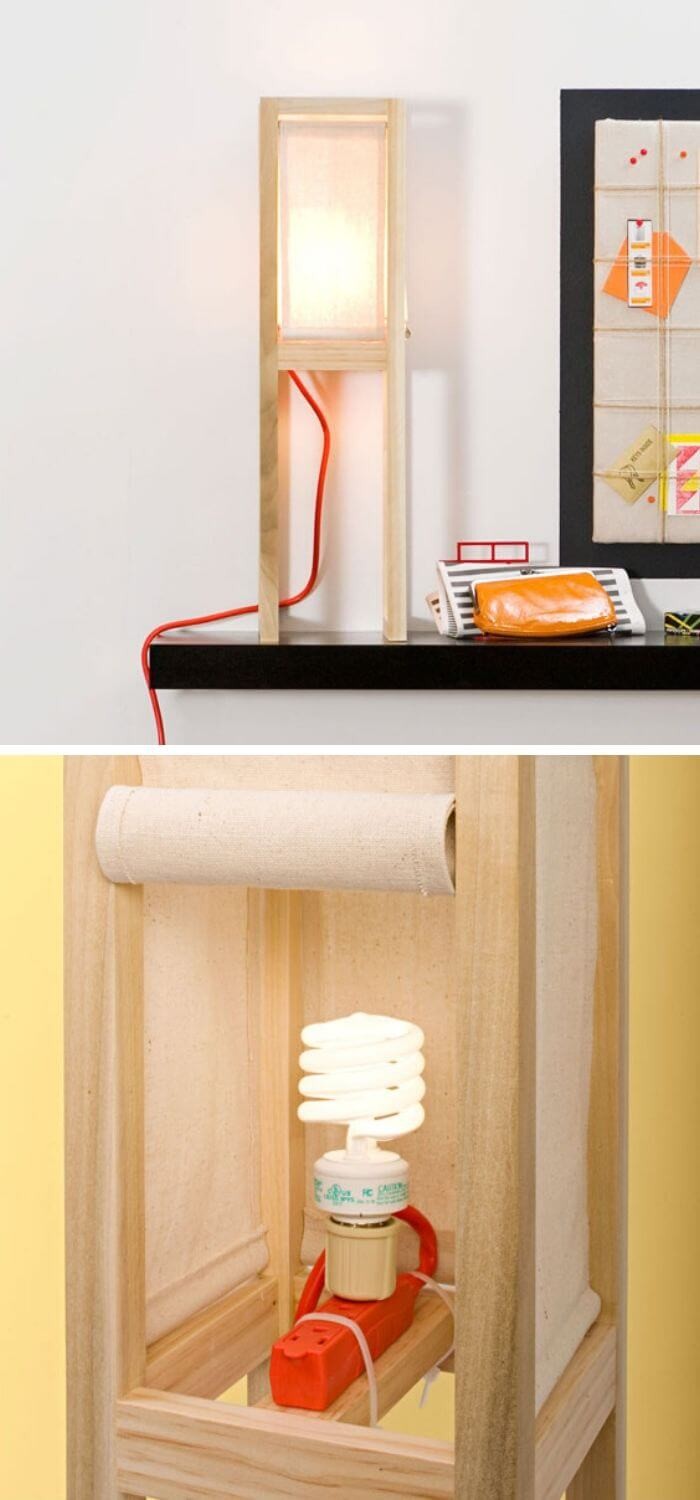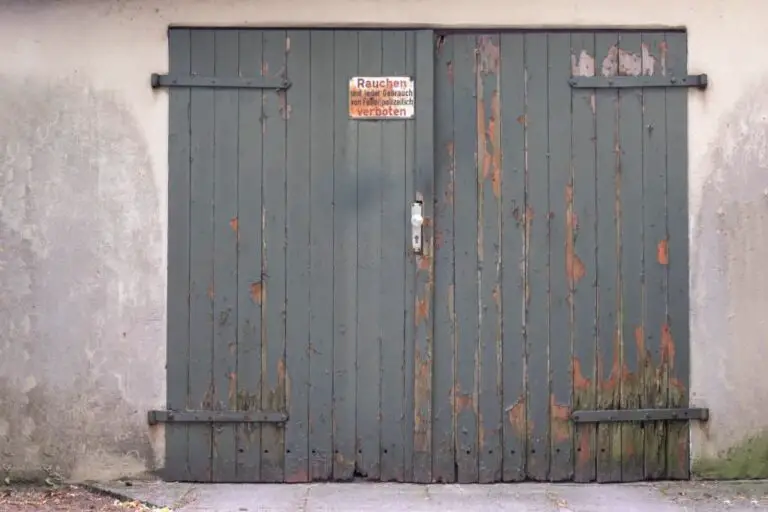43 Different Types Of Grass Choose The Right Lawn For Your Yard
Grass has been a timeless landscaping element for centuries, providing a lush and inviting green space that brings people together. While it’s an organic component, maintaining its beauty requires some effort, including regular watering and other upkeep tasks. Fortunately, not all grass types require the same level of maintenance, with some being more low-maintenance than others.
This article aims to explore the various grass species that you can consider for your own lawn, from Bermuda grass to Mondo grass, and everything in between. With over 40 different types to choose from, there’s something for every climate and personal preference. Some of these species, like St. Augustine grass, are well-suited to warm climates, while others, such as Fine fescue grass, thrive in cooler temperatures.
Then there are the ornamental grasses, like Fountain grass and Pampas grass, that add a touch of elegance to any landscape. Whether you’re looking for a durable and low-maintenance option or something more exotic and decorative, this article aims to give you a comprehensive overview of the many different types of grass out there. So, go ahead and start exploring – you never know what hidden gem you might discover!
#1. Bermuda grass (Cynodon dactylon)
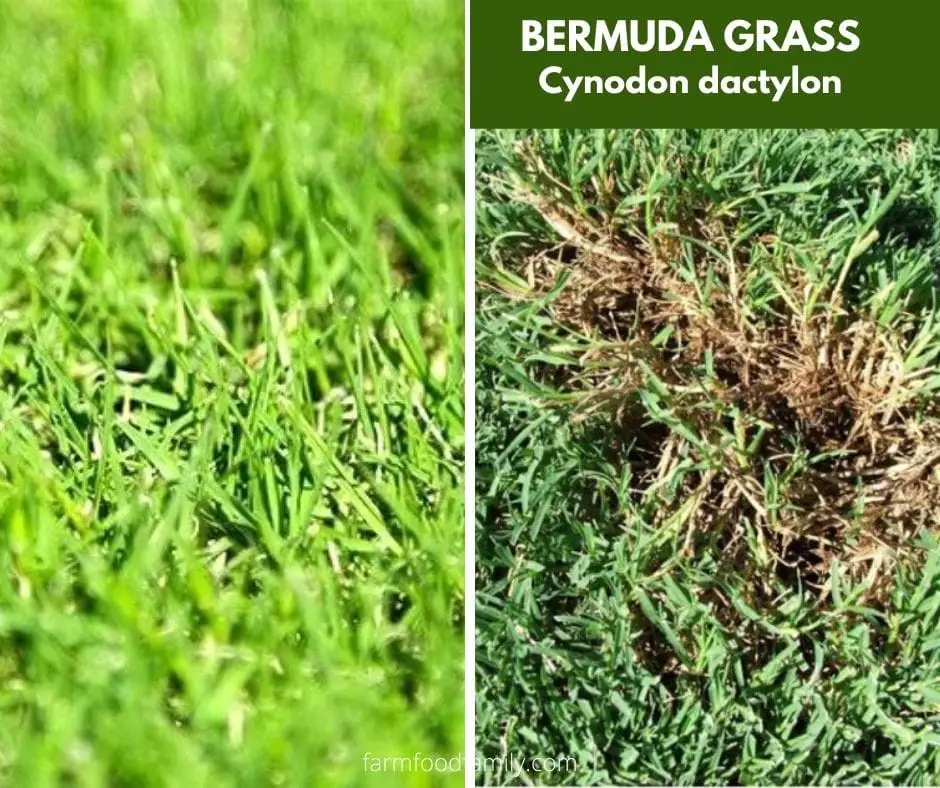
For a dense and lush lawn, look no further than Cynodon dactylon, commonly known as Bermuda grass. Its striking deep green leaves with pointed tips are accompanied by a fast-growing rhizome root system that can quickly cover large areas, making it an ideal choice for lawns, athletic fields, and more. As a warm-season grass, Bermuda grass is surprisingly resilient, tolerating drought, salt, and heavy foot traffic.
However, to keep your lawn looking its best, you’ll need to provide regular watering and fertilization, as well as occasional mowing. A perennial weed that can grow up to 12 inches tall, Bermuda grass thrives in full sun and can adapt to a range of soil types, including clay, loam, sand, and shallow rocky soil. Its moderately acidic to neutral soil pH tolerance also makes it a versatile choice for many lawns.
While it doesn’t produce showy flowers, its raceme blooms are a subtle yet attractive feature. With hardiness zones ranging from 7-10, Bermuda grass is native to East Africa and India.
#2. Centipede grass (Eremochloa ophiuroides)
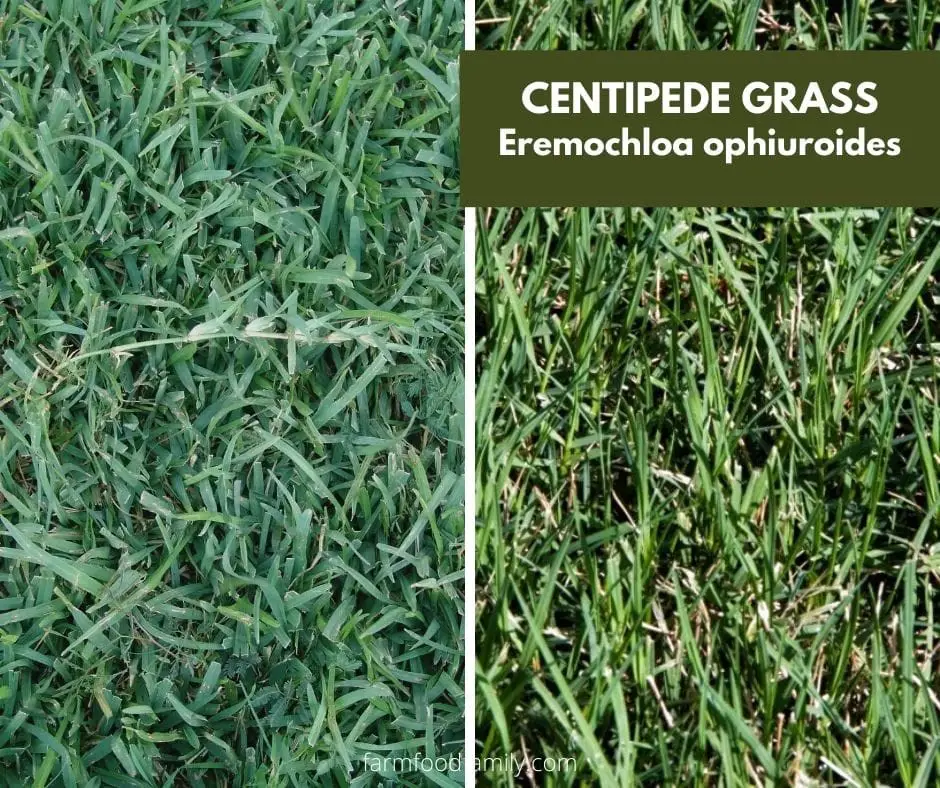
Centipede grass is a warm-season turfgrass that excels at creating a dense lawn. Its distinctive feature is its horizontally growing leaves with a notched shape, typically displaying a vibrant green color. Like Bermuda grass, it thrives in full sun and requires regular watering. However, Centipede grass exhibits greater tolerance for high traffic and can be maintained by mowing it short, reducing the frequency of mowing.
This perennial grass type is characterized as stoloniferous, with stolons allowing it to spread quickly. When mature, it reaches a height of 10 inches. Centipede grass tolerates a range of soil conditions, including clay, loam, sand, and shallow rocky substrates, with a moderately acidic pH. Notably, this grass does not produce flowers. In terms of hardiness, it thrives in zones 7-10. Its native regions include Southeast Asia, South America, and Africa.
#3. St. Augustine grass (Stenotaphrum secundatum)
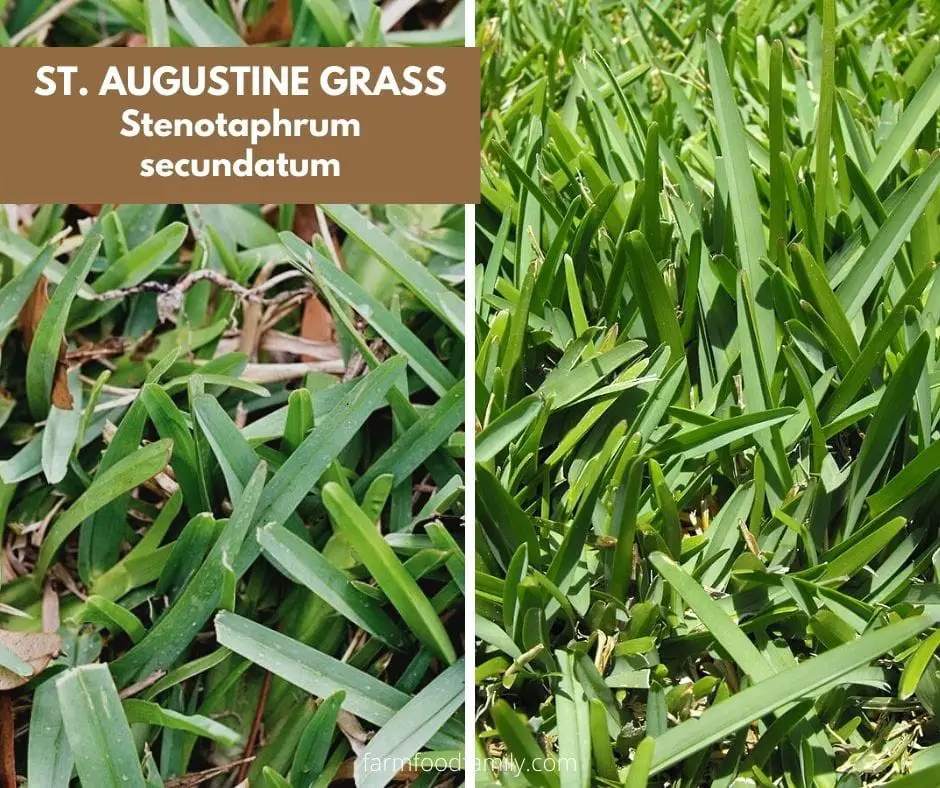
St. Augustine grass is renowned for its remarkable resilience and ability to withstand pests. Characterized by slow growth and broad, coarse leaves with rounded tips, this species thrives in sandy soil conditions that are frequently watered. Its capacity to provide a lush carpet-like lawn and tolerate heavy foot traffic makes it an excellent choice for many homeowners. While it does have specific requirements, St.
Augustine grass is capable of flourishing in environments ranging from full sun exposure to moderately acidic soils. It’s also worth noting that this perennial ornamental grass can produce green flowers during the summer and fall seasons. As a turf grass, it typically reaches a mature size of 6-12 inches and has hardiness zones ranging from 8-10. Its native range spans Southeastern USA, Central America, and Africa.
#4. Zoysia grass
Zoysia is a perennial grass species that thrives in warm seasons. Its stiff and coarse leaves are characteristic of its growth pattern. Notoriously slow-growing, this turf grass demands full sun to flourish and becomes dormant during the colder months. As the warmer seasons return, Zoysia’s foliage turns green once more. Moreover, it can survive with infrequent watering, making it a relatively low-maintenance option for landscapers.
Key characteristics of Zoysia include its botanical name (unspecified), common name, perennial plant type, mature size ranging from 6-12 inches, full sun exposure requirement, tolerance for rocky and clay soils with good drainage, slightly acidic soil pH, lack of significant blooms, and hardiness zones spanning 5-10. Interestingly, Zoysia originates from Korea, where it has evolved to thrive in its native environment.
#5. Dichondra – Kidney weed
While not a true grass, Dichondra argentea, also known as Kidney weed or silver nickel vine, exhibits some grass-like qualities during the warmer months. This flowering plant, closely related to morning glories, boasts creeping stems and deep green leaves that require regular fertilization and trimming to thrive. With its mature size reaching 4 inches, this trailing herbaceous perennial is well-suited for use as a ground cover.
Characteristics of Dichondra argentea include its botanical name, which provides a unique identifier within the plant kingdom. Its common names, Kidney weed and silver nickel vine, offer a more relatable label for those less familiar with botanical terminology. The plant’s growth habits, such as its ability to thrive in dappled sunlight to full sun, make it an attractive option for gardeners seeking low-maintenance options.
Dichondra argentea prefers loam (silt), sand, or well-draining soil and can tolerate slightly acidic pH levels. It blooms during the spring season, producing yellow, white, or green flowers that add a pop of color to any landscape. Its hardiness zones range from 10b-12a, making it suitable for gardeners in these regions. Finally, its native area includes the United States and Mexico.
#6. Pampas grass (Cortaderia selloana)
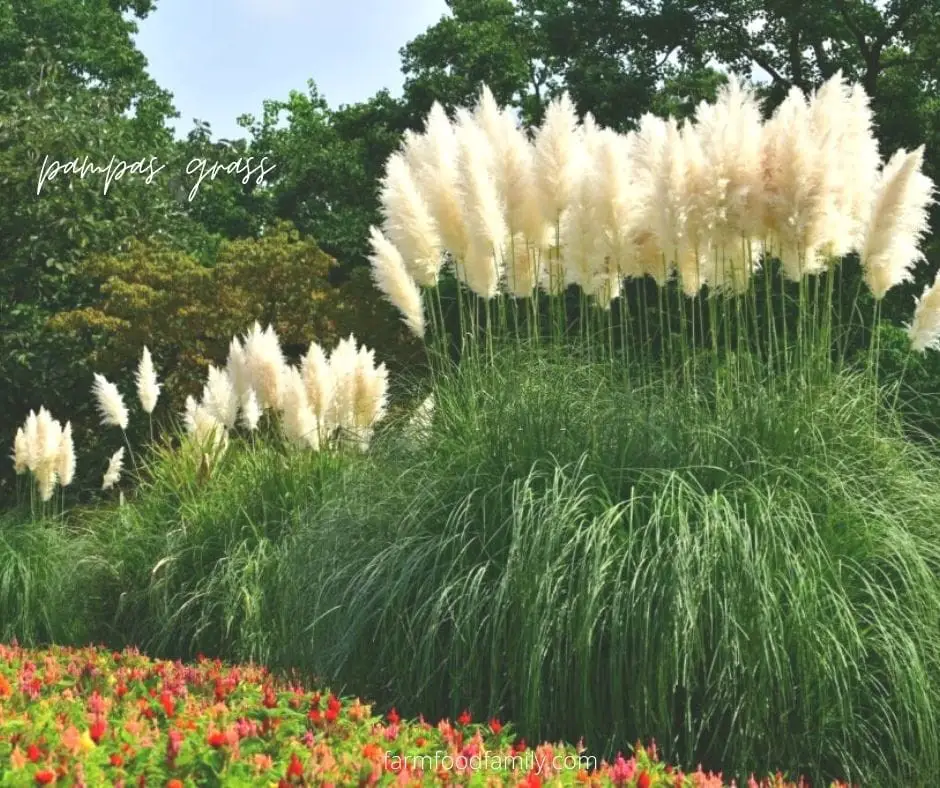
Cortaderia selloana, commonly referred to as Pampas grass, is an ornamental grass that thrives in large clumps with distinctive white, feather-like plumes. Its versatility and low maintenance requirements make it a popular choice for wide landscape areas. When well-established, the roots of this grass type can spread rapidly, posing an invasive threat if left unchecked.
Characteristics include:
– Botanical name: Cortaderia selloana
– Common name: Pampas grass
– Plant type: Ornamental grass
– Mature size: 8-12 feet tall
– Sun exposure: Full sun to partial shade
– Soil type: Sand, loam (silt), and well-draining soil
– Soil pH: Slightly acidic range
– Bloom time: Spring and summer with a show of cream, gray-silver, tan, pink, and white flowers
– Hardiness zones: 7-10, making it suitable for temperate climates
– Native area: South America
#7. Monkey grass (Liriope spicata)
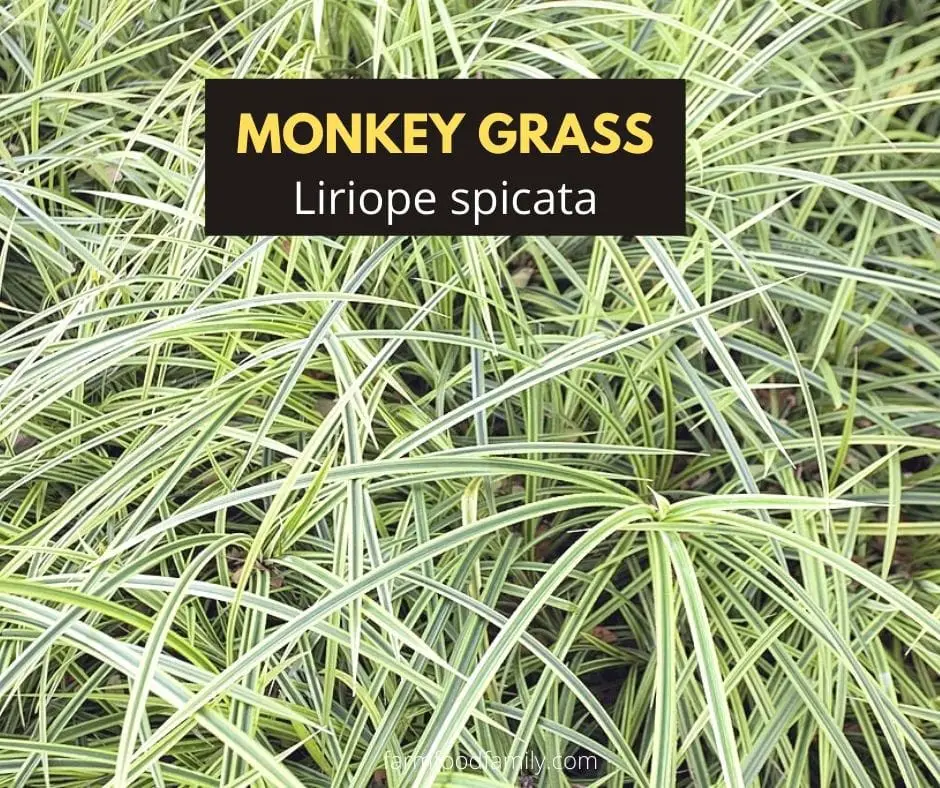
Liriope spicata, also known as Monkey grass, creeping liriope, or lily grass, is a hardy and adaptable ornamental grass that can thrive in challenging conditions. It tolerates high heat, heavy shade, and intense foot traffic, making it an excellent choice for lawns and landscaping. This versatile plant is somewhat toxic to critters like deer and rabbits, which helps protect it from damage. However, when left unchecked, Liriope spicata can become invasive.
Its attractive foliage changes color with the seasons: dark green in summer and spring, and bronze-green during winter. As a popular turf grass alternative, it offers a low-maintenance option for lawns. Botanically, this herbaceous perennial belongs to the family Asparagaceae and is native to Southeast Asia, China, and Japan. It prefers well-draining soil with a neutral to slightly acidic pH and can thrive in zones 4-10.
#8. Bahia grass (Paspalum notatum)
Bahiagrass (Paspalum notatum) is a versatile plant that thrives in various environments. As a pasture grass, it provides a nutritious food source for livestock. Additionally, its low-growing habit makes it an ideal ground cover, suppressing weeds and preventing erosion. One of its most impressive features is its ability to adapt to diverse soil types, including sandy, rocky, and well-draining conditions. It’s also remarkably resilient, tolerating both full sun and partial shade.
Once established, Bahiagrass can outcompete weeds for resources, making it a valuable tool in landscaping and gardening. Furthermore, it exhibits strong resistance to pests and critters, minimizing the need for pesticides and other chemicals. With its mature size reaching up to 3 feet, this plant is suitable for ornamental use as well. Its preferred growing conditions include full sun to partial shade and slightly acidic to high-nitrogen soils with a pH range of slightly acidic.
It’s hardy in zones 8-11 and native to Central and South America, as well as the Midwest USA.
#9. Mondo grass (Ophiopogon japonicus)

Ophiopogon japonicus, also known as Mondo grass or dwarf lilyturf, is a unique herbaceous perennial that thrives in partial shade. Unlike other members of the grass family, it belongs to the lily family and has tuberous roots. Its stemless nature means that its leaves grow in clumps, making it an effective ground cover. Despite its non-grass classification, it shares many characteristics with grasses, including a tendency to form dense clumps.
In terms of its growing requirements, Mondo grass prefers partial shade to full sun and can thrive in a variety of soil types, including clay, loam, sand, and rich, moist, well-drained soils. It also has a slightly acidic soil pH preference. In the spring, it produces bell-shaped flowers that come in a range of colors, including white, pink, and purple/lavender. As an herbaceous perennial, Mondo grass grows to be around 9-12 inches tall and is hardy in zones 6-10.
Its native area includes China, Korea, and Japan.
#10. Fine fescue grass (Festuca spp.)
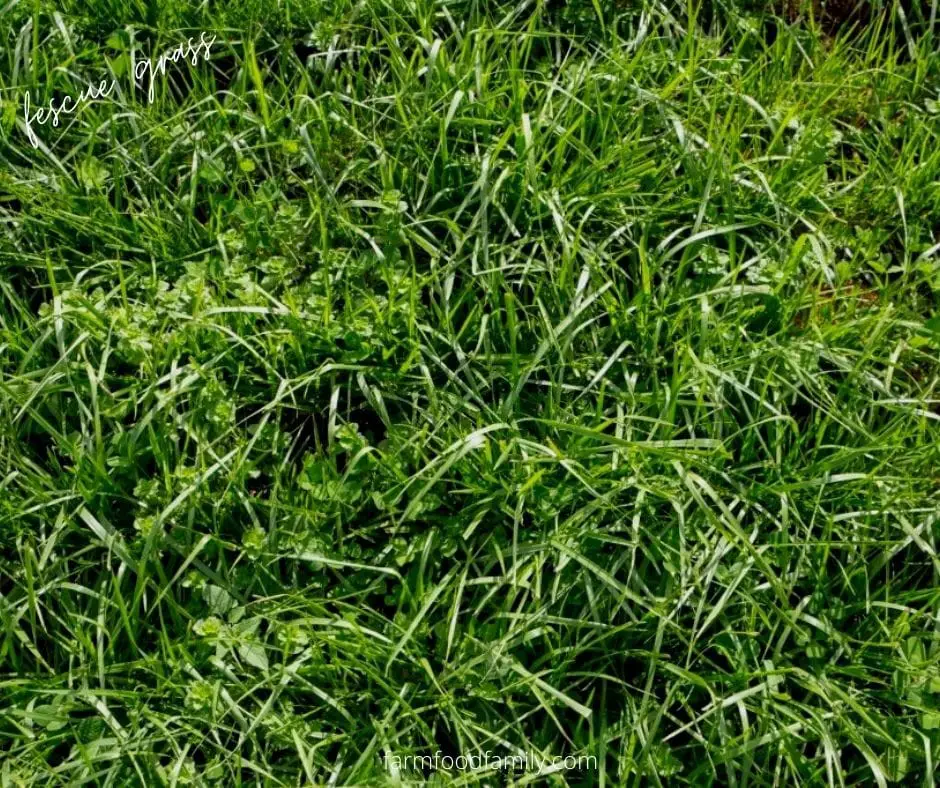
Fine fescue is a type of turf grass that thrives with fast growth and slender, pointed leaves. While it can’t tolerate extreme conditions like full sun or full shade, it excels in northern regions, making it a cold-season grass. Its popularity stems from its inclusion in mixed lawn seeds, often paired with blue and red ryegrass. With over twenty cultivars to choose from, Fine fescue offers a range of options for gardeners. Botanically speaking, Fine fescue is classified as Festuca spp.
, with common names like Fine fescue and turf grass. It also doubles as an ornamental grass. As it reaches maturity, Fine fescue requires soil that’s well-draining, moist, and rich in nutrients – think clay, loam, or sand. Its ideal pH range is moderately acidic to neutral. In the spring, Fine fescue blooms with golden and yellow hues, adding a pop of color to any landscape. Its hardiness zones lie between 7 and 10, making it suitable for gardens across North America, South America, and Mexico.
#11. Crabgrass (Digitaria sanguinalis)
Crab grass (Digitaria sanguinalis) is a summer annual that can quickly spread and become invasive if not properly managed. Its robust stems, also known as legs, give it its distinctive name. This hardy turfgrass is notoriously difficult to control, able to evade lawn mowers with its short stature and adaptability. It thrives in areas with high foot traffic due to its indestructible nature.
The plant’s deep green, coarse leaves can reach up to 5 inches in length, making it a suitable choice for zones with partial shade or full sun. Crab grass prefers loam-based soils that are moist and moderately acidic to neutral in pH. It typically blooms during the fall and summer seasons, producing brown/copper and green flowers. The plant is native to Eurasia and hardy enough to grow in zones 2b-11a.
#12. Fountain grass (Pennisetum alopecuroides)
Pennisetum alopecuroides, also known as Fountain grass or Hameln, is a clumping perennial ornamental grass that boasts slender, arching leaves. As these leaves mature, they produce brown/tan, brush-like flowers with spiky textures that remain intact even after they dry up. This hardy grass thrives in conditions of drought and cold, making it an excellent choice for areas prone to such weather patterns. Furthermore, it is remarkably resilient when damaged, recovering quickly from any harm.
Its popularity as an ornamental grass lies in its ability to add a unique touch to landscaping designs. Characteristics that set Pennisetum alopecuroides apart include its mature size of 3-6 feet, full sun to partial shade tolerance, and adaptability to various soil types, including those with good drainage, occasional wetness, or dry conditions. The plant’s tolerance for moderately acidic to slightly alkaline soil pH values adds to its versatility.
In terms of blooming habits, Pennisetum alopecuroides typically produces flowers in the summer and fall seasons, with a range of colors including cream/tan, pink, white, and purple. Its hardiness zones span from 5b to 9a, allowing it to flourish in various regions. Native to Africa and South Asia, this grass is now cultivated worldwide for its ornamental value.
#13. Kentucky bluegrass (Poa pratensis)
Kentucky bluegrass (Poa pratensis) is a highly sought-after cool-season grass due to its remarkable ability to quickly recover from damage. This resilient turf grass can withstand heavy foot traffic and regular lawn maintenance, such as mowing. It thrives in full sun or partial shade conditions, although it may struggle with growth in deep shade. Characterized by its deep green, V-shaped leaves, Kentucky bluegrass is a dense perennial that can reach heights of 12-24 inches.
In terms of growing requirements, it prefers well-drained soil with moderate acidity (pH) and can tolerate a range of sun exposure from full sun to partial shade. When in bloom, the grass produces greenish-white flowers in both spring and fall seasons. Kentucky bluegrass is hardy in zones 3a-7a and originates from Europe, North Asia, Algeria, and Morocco.
#14. Buffalo grass (Bouteloua dactyloides)
Buffalo grass (Bouteloua dactyloides) is a hardy, perennial prairie grass that excels in challenging environments. Its natural habitats include pasture lands and sod feeders, where it thrives despite drought and shade conditions. This adaptable grass forms a dense, thick turf that’s ideal for lawns or ornamental landscaping. However, its winter dormancy may lead homeowners to reconsider planting this species as a primary lawn choice.
Key characteristics of Buffalo grass include:
Mature size: 3-12 inches
Sun exposure: Full sun to partial shade
Soil type: Clay, loam, and moist soils
Soil pH: Slightly acidic to neutral
Bloom time: Late summer to fall, with occasional summer blooms
Flower color: Bright yellow
Hardiness zones: 3-9
Native range: Canada, United States, and Mexico
#15. Pink muhly grass (Muhlenbergia capillaris)
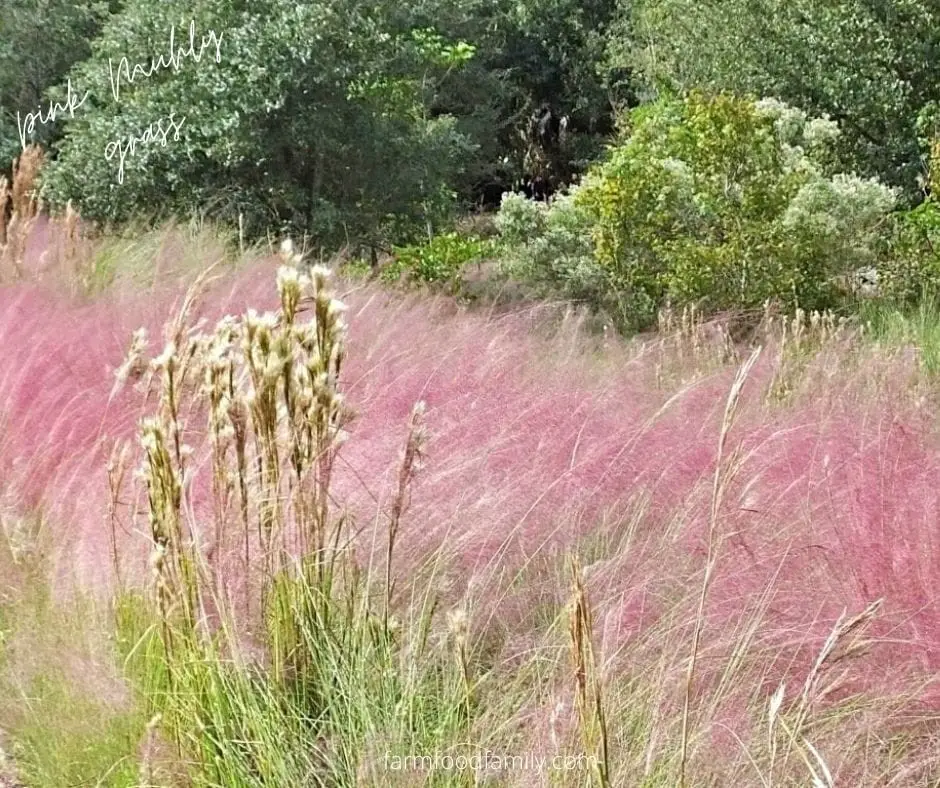
Muhlenbergia capillaris, also known as Sweet Grass or Mist Grass, is a highly sought-after ornamental grass for its striking pink flowers and white plumes that bloom during the winter and fall seasons. This perennial grass grows in clumps, making it an excellent choice for adding texture and interest to native gardens and borders alike. Its rapid growth rate and low maintenance requirements only add to its appeal.
When fully grown, Muhlenbergia capillaris reaches a mature size of 3 feet, requiring full sun to partial shade for optimal growth. It thrives in well-drained soils with moderate moisture levels, tolerating sandy, rocky, or slightly acidic conditions. While it can tolerate a range of soil pH levels from moderately acidic to slightly alkaline, it truly flourishes when given the right balance.
This versatile grass produces a kaleidoscope of colors during its fall and summer bloom times, showcasing pink, purple, lavender, and burgundy hues. As a hardy perennial, Muhlenbergia capillaris is suitable for USDA Hardiness Zones 5-9. Native to Central USA, Guatemala, and the Caribbean, it’s an excellent choice for those looking to incorporate native plants into their landscaping design.
#16. Foxtail grass
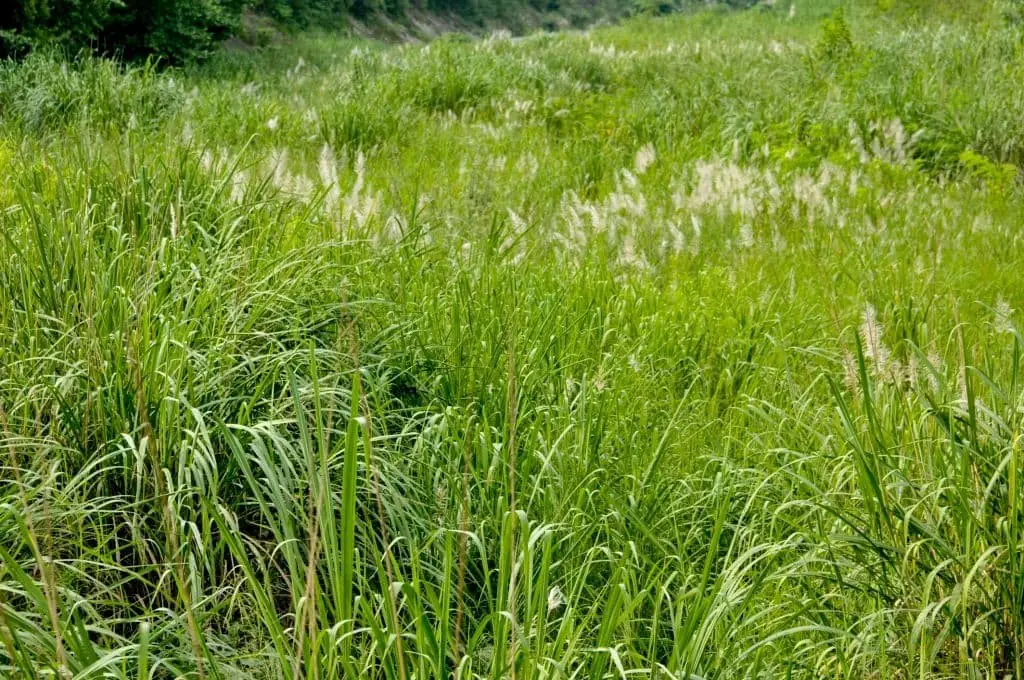
The Calamagrostis brachytricha, also known as Foxtail grass, diamond grass or reed grass, is a warm-season ornamental grass that boasts arching leaves and clumps. It’s during the summer months that this beauty produces pink plumes, adding a pop of color to any landscape. This hardy perennial can thrive in full sun with adequate moisture, and its natural resistance to common deer feeders makes it a great choice for those looking to minimize maintenance.
With its mature size reaching 3-4 feet, it’s an ideal addition to any garden or outdoor space. Calamagrostis brachytricha is tolerant of clay, loam, and occasionally wet soils, with a slightly acidic pH. The blooms appear during the fall and winter seasons in shades of pink, purple/lavender, and cream. Native to Central and Eastern Asia, this ornamental grass can be grown in hardiness zones 4-9.
When considering companion plants, keep in mind that Calamagrostis brachytricha is often found alongside similar species.
#18. Perennial ryegrass
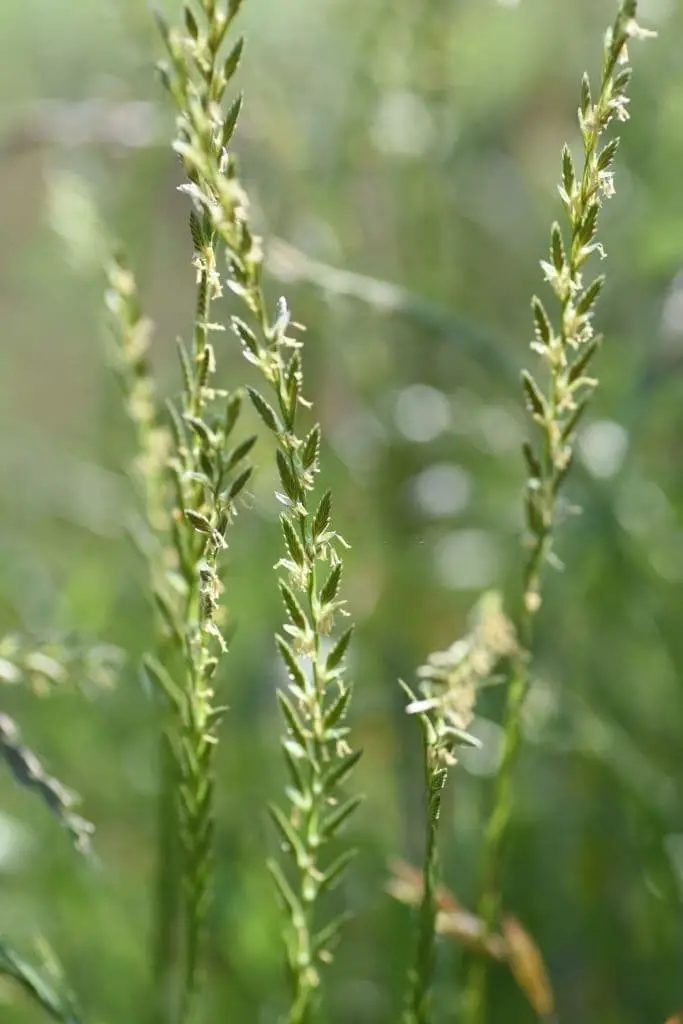
English/Italian ryegrass (Lolium perenne) is a versatile turf grass that stands out for its rapid germination rate among cool-season varieties. This adaptability extends to its tolerance of varying light conditions – it thrives in both full sun and partial shade, making it an ideal choice for lawns with diverse sunlight patterns. Additionally, this ryegrass species is remarkably resilient to high foot traffic, ensuring a lush appearance even in heavily used areas.
Its slender, pointed leaves are often blended with Kentucky bluegrass to create a more shade-tolerant turf. With its mature size ranging from 2-3 feet, English/Italian ryegrass can be grown in a variety of settings. It excels in well-draining soil types including sand, clay, loam, and is equally comfortable in acidic or alkaline environments.
While it may not be renowned for its showy blooms, this turf grass is hardy in zones 2-8 and native to Central Asia, the Middle East, North Africa, and Southern Europe.
#19. Tall fescue grass

Tall fescue grass (Festuca arundinacea) is a unique cool-season turf that excels in dry and hot weather conditions, making it an ideal choice for many homeowners. Its dark green, coarse, and thick blades are highly tolerant of high foot traffic and mowing equipment, ensuring a lush and healthy lawn even in areas with heavy use. While it may grow in clusters at times, the overall appearance is still beautiful and attractive.
The grass has a mature size ranging from 4-12 inches, making it suitable for lawns of various sizes. It thrives in full sun to partial shade and can adapt to a range of soil types, including clay, loam, and well-draining soils with a moderately acidic to neutral pH. Additionally, it blooms in the fall and spring seasons, but does not produce showy flowers. Tall fescue grass is hardy in zones 3-8 and originates from Europe, making it an excellent option for many regions.
#20. Timothy grass
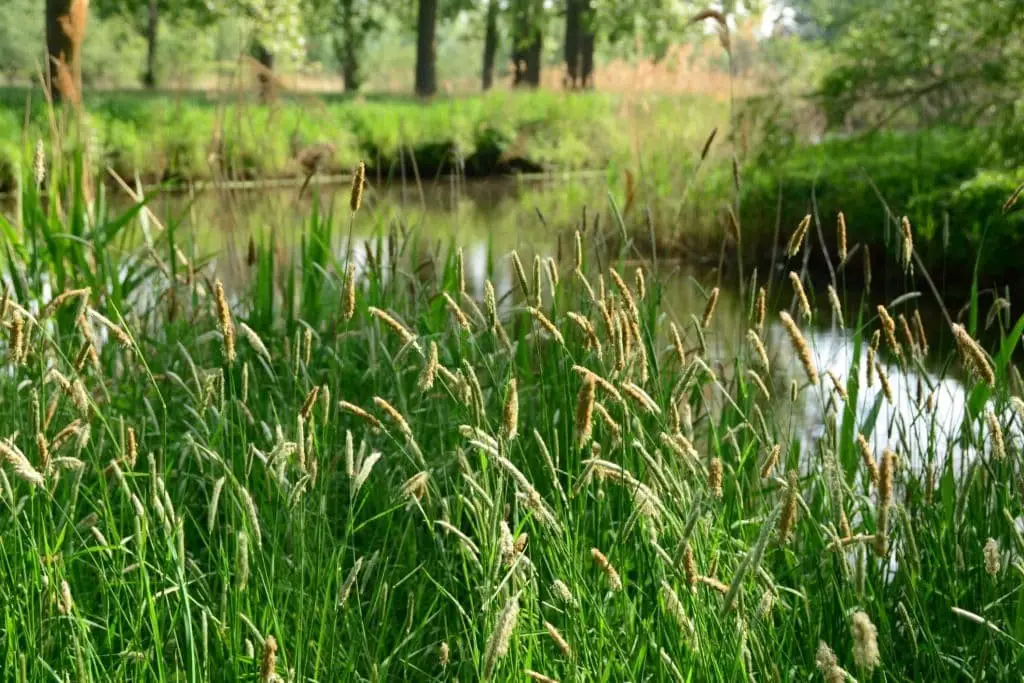
Timothy grass is a distinctive perennial that boasts a single stem and a relatively short lifespan. Characterized by its clumping growth habit, this cool-season grass plays a vital role in European and Asian pastures. Its fibrous roots terminate in brush-like plumes, adding to its unique appearance.
As a fast-growing species, Timothy grass can quickly spread when left unchecked, earning it the reputation as an invasive weed in certain circumstances.
Some key details about this plant include:
Botanical name: Phleum pratense
Common name: Timothy grass
Plant type: Herbaceous perennial, forage grass
Mature size: 20-40 inches tall
Sun exposure: Full sun to partial shade
Soil type: Sand, loam, tilled soil with good drainage
Soil pH: Slightly acidic to neutral (6.0-7.0)
Bloom time: Summer and spring
Flower color: Pink, green, and white
Hardiness zones: 3-9
Native area: Europe, Asia, and North Africa
#21. Quack grass
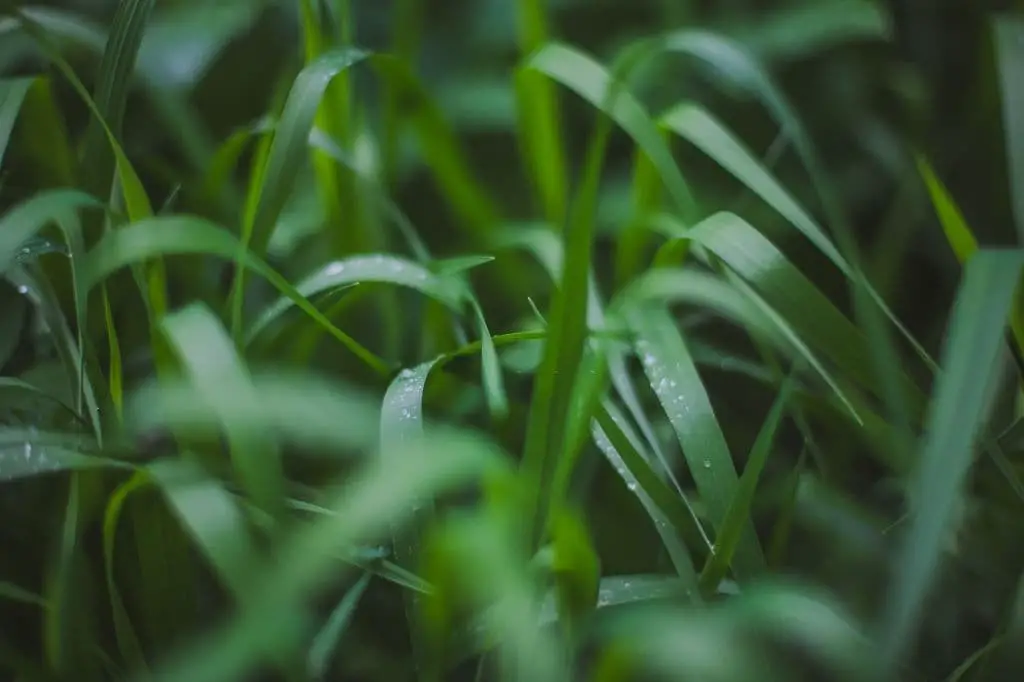
Couch grass, also known as quack grass, is a perennial weed-like species that thrives in northern temperate regions. Despite its reputation as a nuisance, it has several valuable uses – it can be cultivated as forage, used for erosion control, or even employed as turf. Its flat, hairy leaves and white, yellow-tipped flowers make it a distinctive sight.
Here are some key details about this species: Botanical Name: Elymus repens; Common name: Couch grass, quack grass; Plant type: Forage grass, turf grass; Mature size: 12-40 inches tall; Sun exposure: Prefers full sun to partial shade; Soil type: Can thrive in a range of soils, including sand, loam, and occasional wet conditions; Soil pH: Neutral to slightly alkaline; Bloom time: Typically in the fall season; Flower color: Features white and green hues; Hardiness zones: Can be grown in zones 3-8; Native Area: Originates from Europe and Western Asia.
#22. Lemon grass
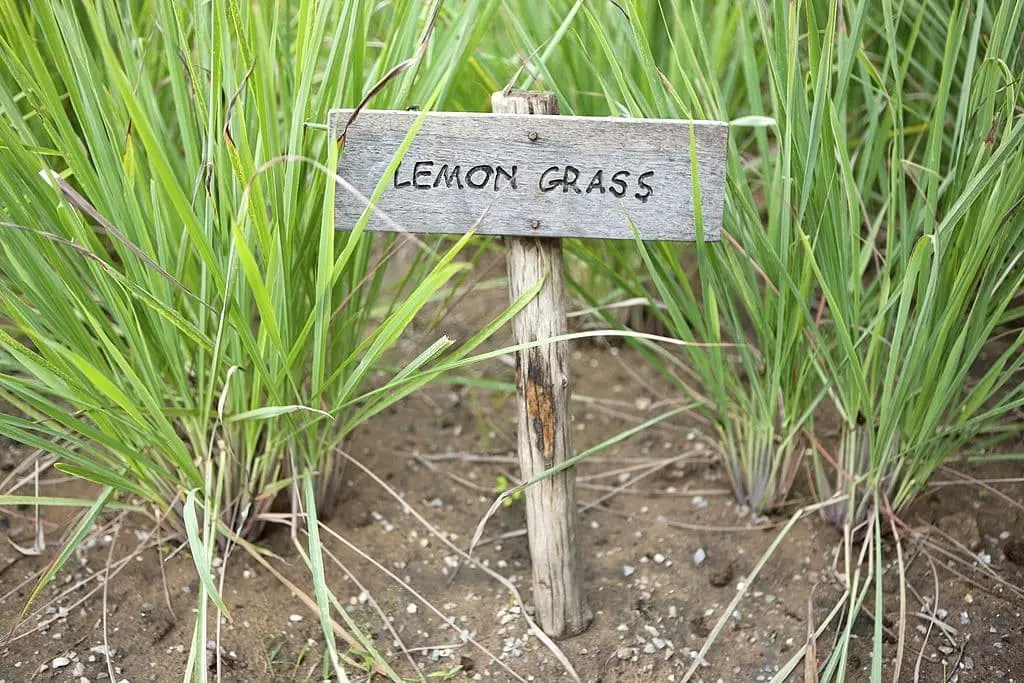
This versatile grass boasts a multitude of uses. Its ornamental value lies in its clumping growth habit and stiff stems, while its leaves can be used as a flavorful herb in various cuisines across Asia and Mexico. Additionally, it’s a rich source of essential oil, which has numerous medicinal properties. Notably, it’s an organic solution for repelling mosquitoes and other insects. The botanical name Cymbopogon citratus is commonly referred to as Oil grass or Lemon grass.
As a plant, it belongs to the ornamental grass, herb, and medicinal plant categories. Mature specimens typically reach 4ft in height, thriving under full sun conditions. Well-suited for loam-based soils with good drainage, this variety tolerates neutral to slightly alkaline pH levels. It’s worth noting that there is no notable flowering period or distinctive bloom color.
Hardiness zones 8b-11a provide the ideal climate range for this plant, which originated in India, Sri Lanka, and Southeast Asia.
#23. Mexican feather grass
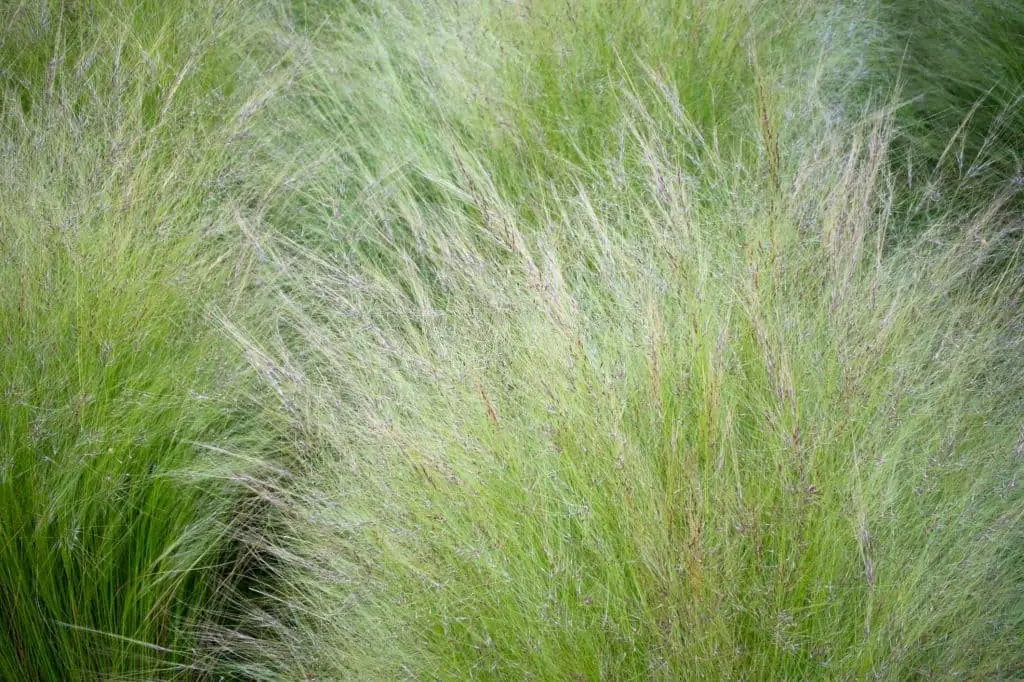
Mexican Feather Grass (Nassella tenuissima) is a unique ornamental grass that boasts an ethereal, feather-like texture that gently sways in the breeze. This adaptable plant thrives with minimal upkeep and can even tolerate dry spells. Its robust nature also allows it to withstand high foot traffic, making it an excellent choice for areas where plants are subject to frequent use. When used strategically, Mexican Feather Grass is a valuable asset for erosion control.
For optimal visual appeal, pair it with ornamental plants or succulents that appreciate similar conditions. Some key characteristics of this perennial include its mature size of 2 feet, sun requirements ranging from full sun to partial shade, and tolerance for a variety of soil types – from clay to sand and everything in between. It’s also quite forgiving when it comes to soil pH, accommodating both acidic and neutral environments.
This low-maintenance grass produces white or silver-gray flowers in the fall and spring, adding an extra layer of charm to its already impressive resume. With hardiness zones spanning 5b-10a, Mexican Feather Grass is a reliable choice for gardeners across a broad range of climates.
#24. Japanese forest grass
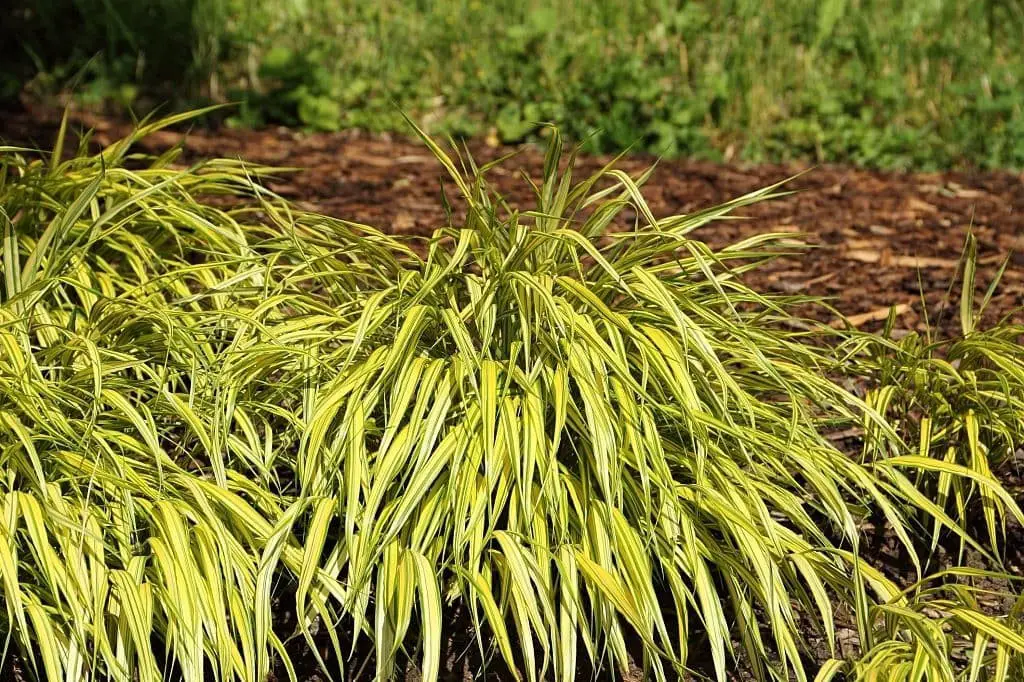
Hakonechloa macra, also known as the Samurai grass, boasts an unconventional growth pattern and unique foliage. Its leaves are characterized by a striking variegation of green and gold hues, while its slender stalks evoke the appearance of bamboo. This ornamental grass is not particularly drought-resistant, demanding frequent watering during arid seasons to thrive. Despite this, it makes for a stunning accent piece when paired with vibrant garden flowers.
When mature, Samurai grass reaches a height of 3ft and prefers partial shade. It thrives in loam-based soils that are moist, well-drained, and slightly acidic, alkaline, or neutral. Blooming occurs during the summer months, but its insignificant spikes fail to steal the show. This deciduous grass is hardy in zones 5-9, hailing from Mt. Hakone in Japan.
#25. Sweet grass

Hierochloe odorata, also known as dune hairgrass, purple muhly, or sweet grass, is a perennial herb native to the southeastern United States. Its distinctive features include rough-edged leaves with hairy undersides and its ability to thrive in a variety of conditions. This versatile plant can tolerate full sun, partial shade, loamy soil, clay, moist environments, and even occasional wetness, making it an ideal choice for ornamental purposes.
It reaches a mature height of around 3 feet and is hardy in zones 3-9. The plant’s most striking feature, however, may be its vibrant fall blooms, which come in shades of pink and purple, adding a pop of color to the landscape during the cooler months.
#26. Zebra grass
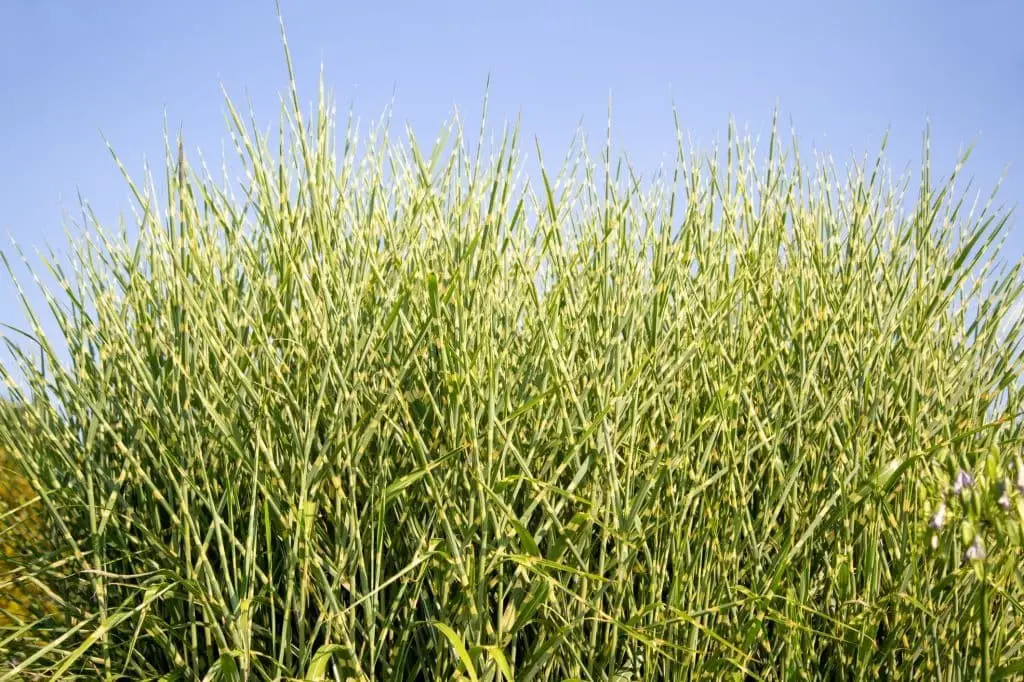
Miscanthus sinensis ‘Zebrinus’, also known as Porcupine grass or Zebra grass, is an ornamental grass that stands out due to its striking green and yellow stripes resembling porcupine spikes. This upright grass has a unique characteristic of dying off in the winter only to come back strong in the spring without needing trimming. Its appeal is further enhanced by its showy flowers which bear a resemblance to plumeria or hibiscus blooms.
As an added bonus, this hardy plant is resistant to drought and erosion, making it an excellent choice for landscaping.
#27. Blue eyed grass

The grass flower, botanically known as Sisyrinchium angustifolium, is a low-growing perennial that thrives in damp environments. Its clumping habit allows it to form a lush carpet of blue-violet blooms in marshy areas, banks, and regions with poor drainage. This adaptable plant can tolerate a wide range of weather conditions, making it an excellent accent plant for cottage-style or native design gardens. In the right setting, it can grow up to 2 feet tall.
When it comes to light, grass flower prefers dappled sunlight to full sun, but will also thrive in partial shade. Its soil preferences are equally broad, with a tolerance for loam, sand, and even occasionally dry conditions as long as the soil is well-draining. The plant’s soil pH range is moderately acidic to alkaline to neutral, and it blooms in the spring and summer months. Expect a vibrant display of blue, purple, or gold/yellow flowers.
Hardy in zones 4a-9a, this North American native can be grown successfully in many regions.
#28. Karl foerster grass
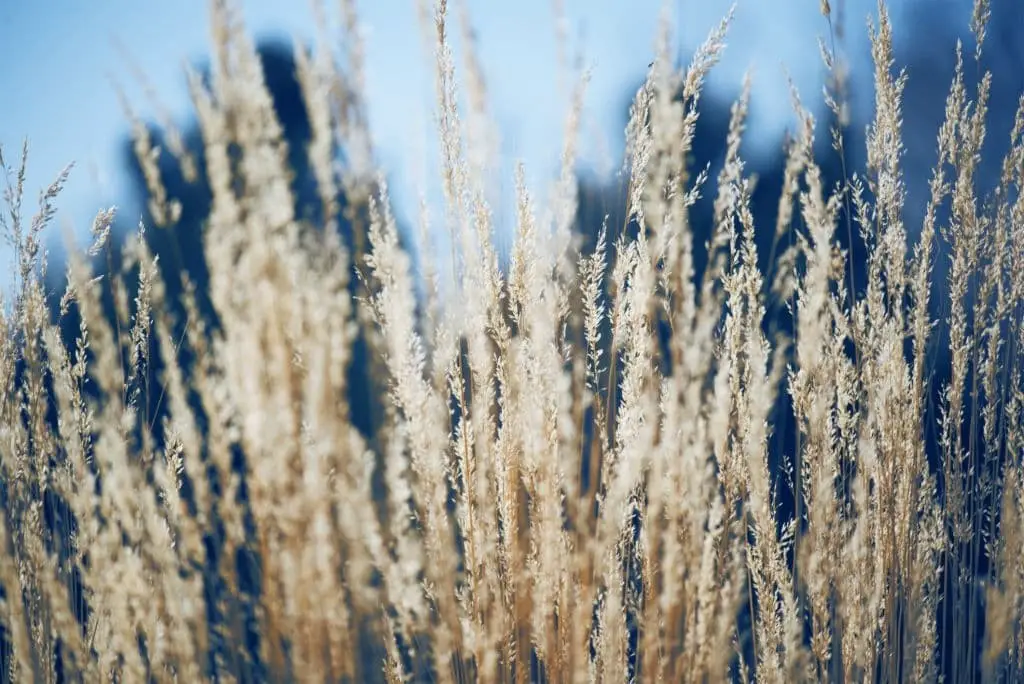
The feather reed grass (Calamagrostis arundinacea ‘Karl Foerster’) is a sought-after ornamental grass due to its unique characteristics. Its delicate, plume-like flowers and ability to thrive in compact soils with minimal maintenance make it an attractive addition to any landscape. Notably, this grass does not reseed, eliminating concerns about invasive growth. Additionally, it is drought-resistant and provides natural defense against deer and other wildlife.
This clumping perennial grows to be around 3-5 feet tall, making it a versatile option for a variety of spaces. It tolerates a range of soil conditions, including clay, normal, and sandy soils, with an adaptable pH from acidic to alkaline. Blooming year-round, the grass produces cream, gold/yellow, or purple flowers, depending on the season. Its hardiness zones span 5-9, making it suitable for a wide range of climates.
Native to Europe, this ornamental grass is a beautiful and low-maintenance addition to any garden.
#29. Orchard grass
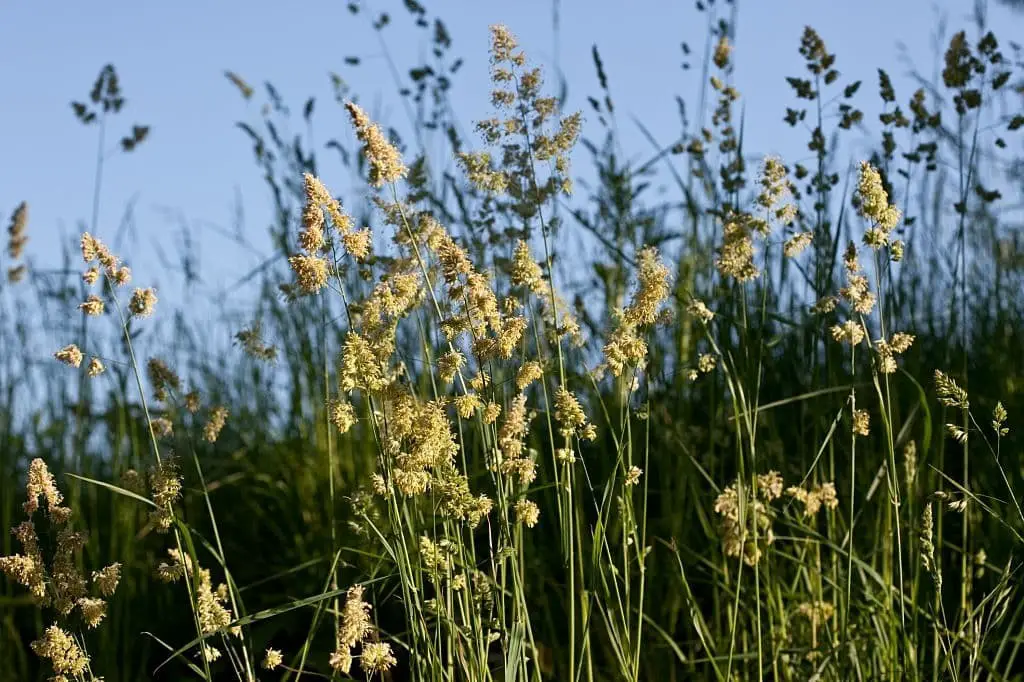
Dactylis glomerata, commonly known as cat grass, is a rapidly growing perennial weed that thrives in cool-season environments. Its bunch-type growth habit makes it an ideal forage and pasture grass in both European and American regions. Notably, its non-rhizomatous roots enable effective erosion control, while its ability to survive in various soil types has led to concerns about its invasive potential.
Despite this, the plant exhibits impressive disease and erosion resistance, making it a suitable choice for livestock feed and even feline snacking. Cat grass is well-suited for environments with full sun to partial shade, and can flourish in clay and loam soils with acidic or neutral pH levels. Blooming periods typically occur during fall and summer, featuring golden to yellow flowers. Its mature size reaches approximately 5 feet, and it is hardy in zones 4a-8a.
Native to regions such as Micronesia, the Mediterranean, temperate climates of Asia, Europe, and Africa, this versatile grass can be explored further through our related read, ‘Straw vs hay’.
#30. Maiden grass
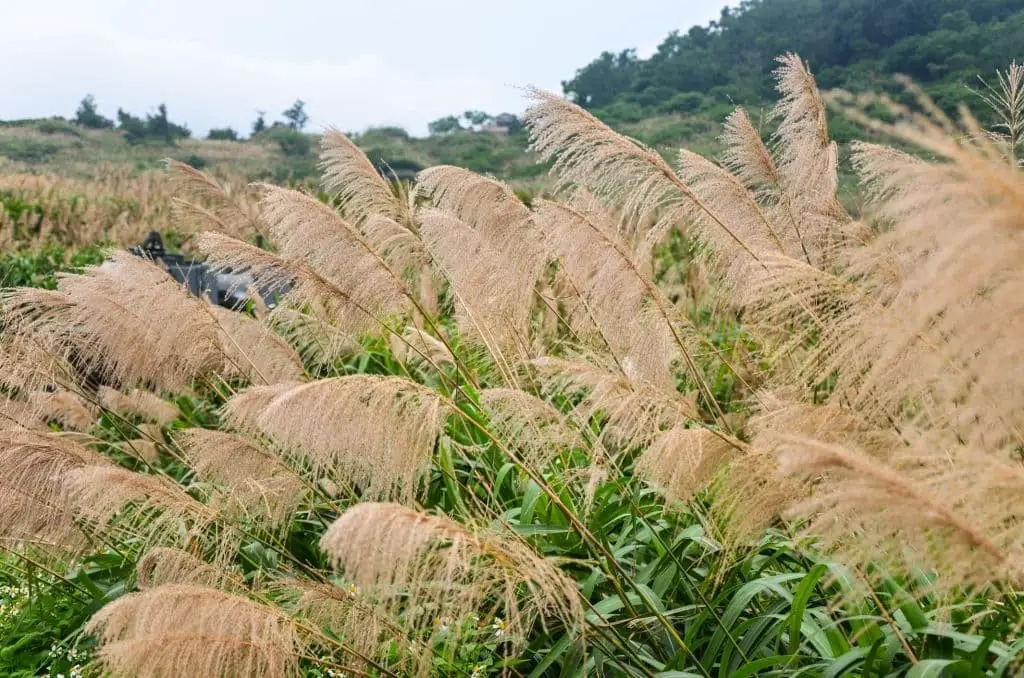
Miscanthus sinensis ‘Gracillimus’, also known as Silver Grass, is a stunning ornamental grass that boasts arching, elegant plumes and deep green foliage in the summer. As fall arrives, the leaves transform into a beautiful burgundy hue. This versatile plant thrives in various settings, making it an excellent choice for adding visual interest to driveways, flower beds, or as a standalone accent piece. It’s also remarkably low-maintenance, tolerating both full sun and partial shade conditions.
What’s more, Silver Grass has the added benefits of repelling insects and deer, while being naturally resistant to diseases. With its mature size reaching 6ft, it’s an ideal addition to any garden or landscape. When it comes to growing conditions, this grass is adaptable to a range of soil types, including clay, sand, loam, and even dry to moist environments with good drainage. Its acidic soil pH (around 5-9) also makes it suitable for areas with slightly acidic to neutral soils.
The plant’s showy copper, gray, and burgundy flowers bloom in the fall, creating a dramatic display that will leave you mesmerized. Native to Korea, China, and Japan, this ornamental grass is hardy across zones 5-9, making it an excellent choice for gardeners seeking a unique, low-fuss addition to their outdoor spaces.
#31. Bear grass
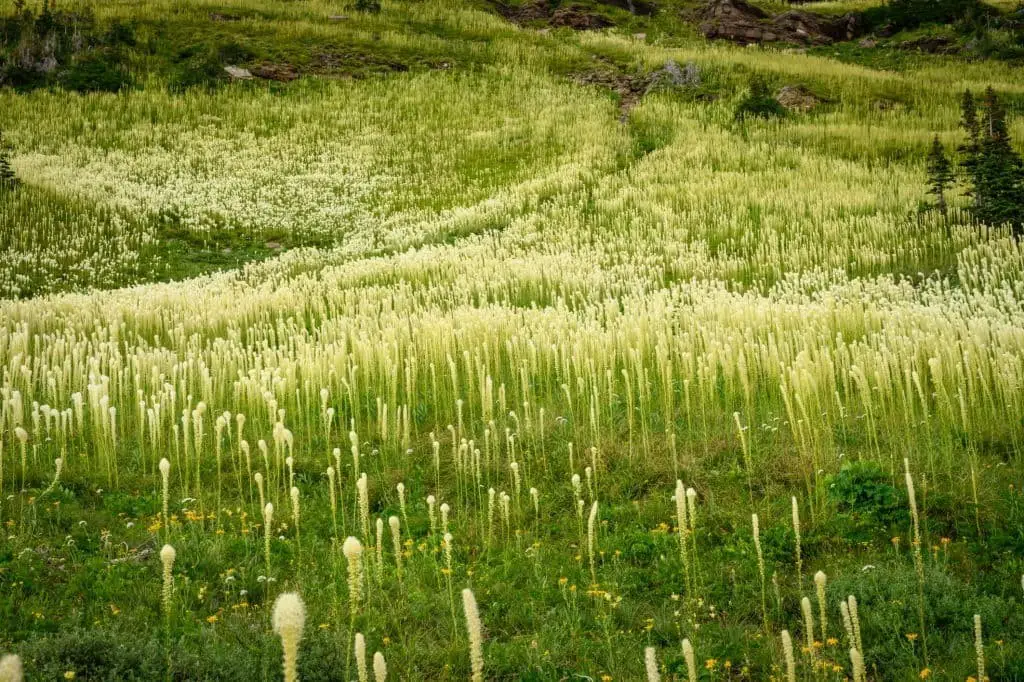
Xerophyllum tenax, commonly known as Indian basket grass, elk grass, or fire lily, is a striking perennial with an unbranched stem that rises from a robust tuber-like root system. Its natural charm lies in its ability to thrive in a variety of conditions, making it a popular choice for ornamental arrangements and floral displays. The plant’s oblong white flowers bloom abundantly during the summer and spring seasons, attracting attention with their subtle greenish-white hue.
Beyond its aesthetic appeal, Xerophyllum tenax has practical applications in erosion control and land revegetation efforts. Its importance extends to Native American rituals and wildlife conservation initiatives. As a hardy perennial, it can thrive in USDA zones 4-8, tolerating partial to full shade and a range of soil conditions from clay to loam. A versatile and low-maintenance addition to any landscape, Xerophyllum tenax is sure to impress with its unique characteristics and adaptability.
#32. Feather reed grass
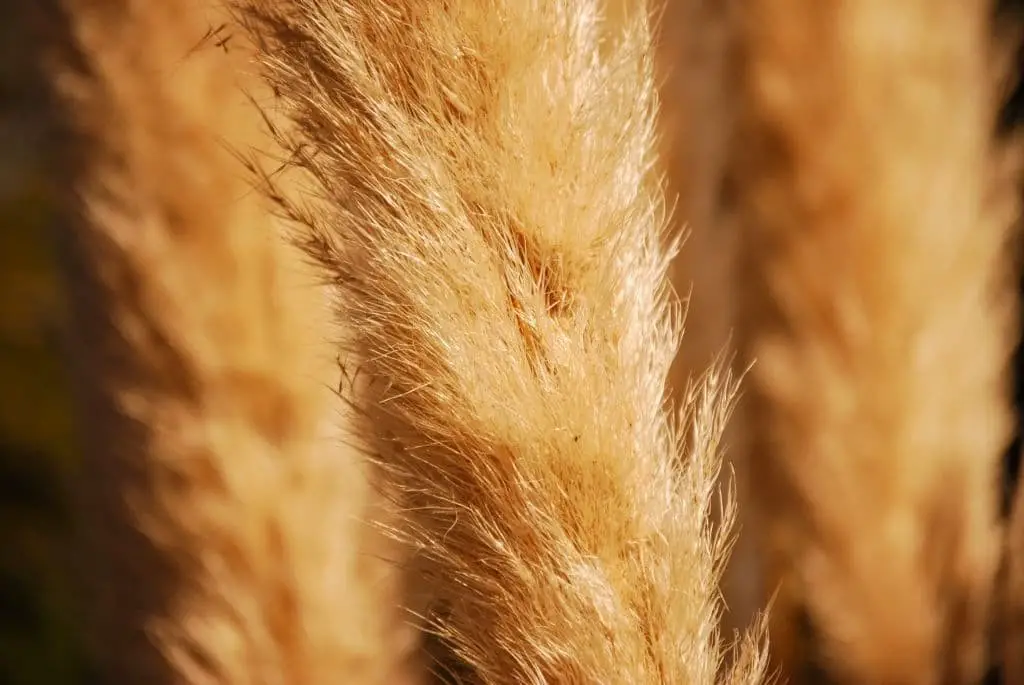
Hybrid ornamental grasses like Calamagrostis x acutiflora, commonly known as feather reed grass or Overdam, are a popular choice for their unique foliage and long-lasting plumes. Characterized by wire-like leaves that form clumps, these plants produce loosely feathered flowers that can be used in both fresh and dried arrangements. One of the benefits of this grass is its ability to withstand winter conditions, making it an ideal addition to any fall or winter display.
Additionally, feather reed grass does not produce seeds, ensuring it remains a non-invasive accent plant. Its natural resistance to pests, insects, and diseases also makes maintenance a breeze.
This ornamental grass has a botanical name of Calamagrostis x acutiflora, but is more commonly referred to as feather reed grass or Overdam. As an ornamental plant, it reaches a mature size of 5ft and prefers full sun to partial shade.
The soil requirements are relatively broad, tolerating clay, moist to very dry conditions, and acidic to neutral pH levels. In terms of bloom time, feather reed grass produces its cream or tan flowers in the fall, making it a great choice for autumnal displays. Its hardiness zones range from 4a-11b, allowing it to thrive in many different climates. The plant is native to North America and Russia.
#33. Elephant grass
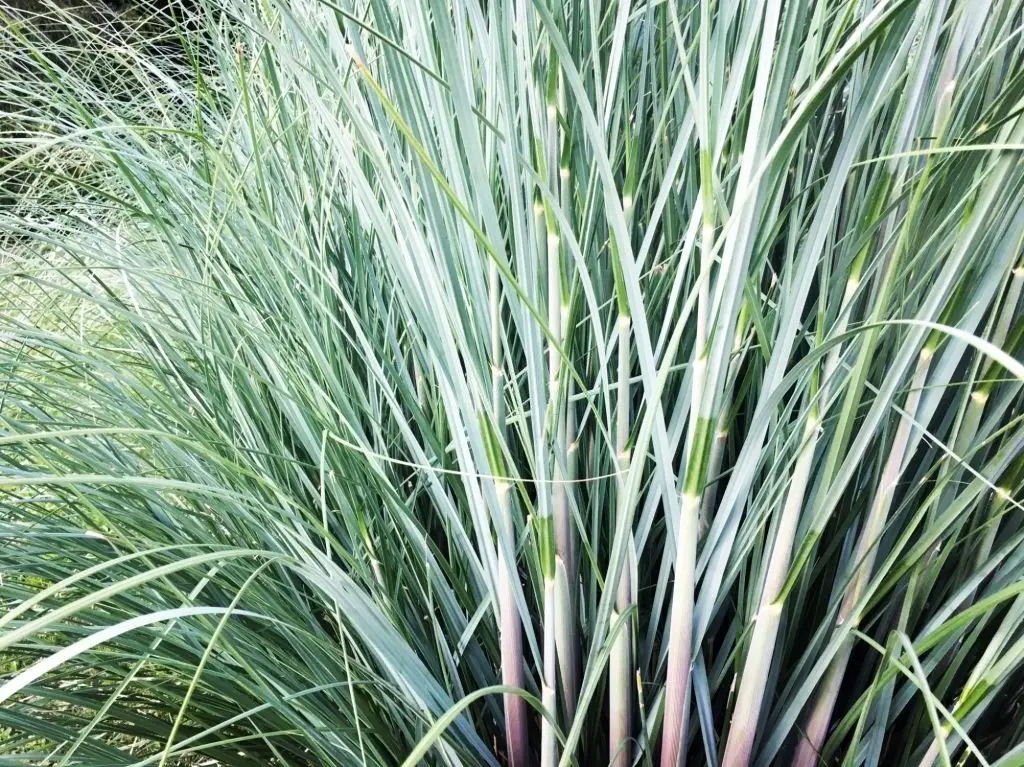
Elephant grass, scientifically known as Pennisetum purpureum, is a tropical plant that has gained popularity for its versatility and unique characteristics. Not only does it provide an ornamental appeal, but its high biomass yield and fast growth rate make it an attractive option for biofuel production. Its low mineral content also makes it a viable alternative to corn-based energy sources.
The grass is known to thrive in both wet and dry conditions, making it a suitable choice for various climates. Additionally, it serves as a valuable forage grass for livestock. With its mature size reaching 6 feet tall, elephant grass requires full sun exposure and medium-moist, well-draining soil with a slightly acidic to neutral pH. It can be grown year-round, producing green and yellow flowers throughout the year. Elephant grass is hardy in zones 8-11 and originates from Sub-Saharan Africa.
#34. Indian grass
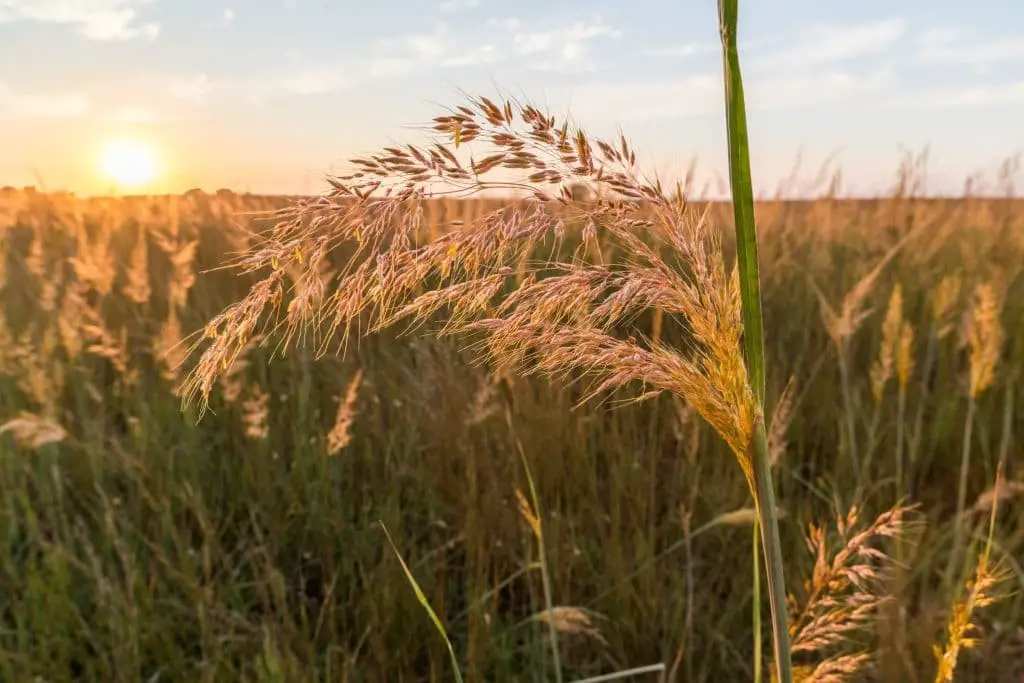
Sorghastrum elliottii, also known as Nodding Indian grass, is a perennial ornamental grass with fibrous roots and distinctive ribbon-like leaves. This native plant boasts impressive resilience, being resistant to pests and deer while tolerating drought conditions. Its nodding flower panicles bloom in both summer and fall, drawing the attention of songbirds and small critters. As an accent grass, it adds a unique touch to winter-themed gardens or lawns.
It thrives in full sun with moist soils that can occasionally be dry, accommodating a wide range of soil pH levels from slightly acidic to neutral. With a mature size of 6ft, this versatile plant is suitable for zones 4-9 and its native area spans central and southeastern USA, including North Carolina.
#35. Sedge grass
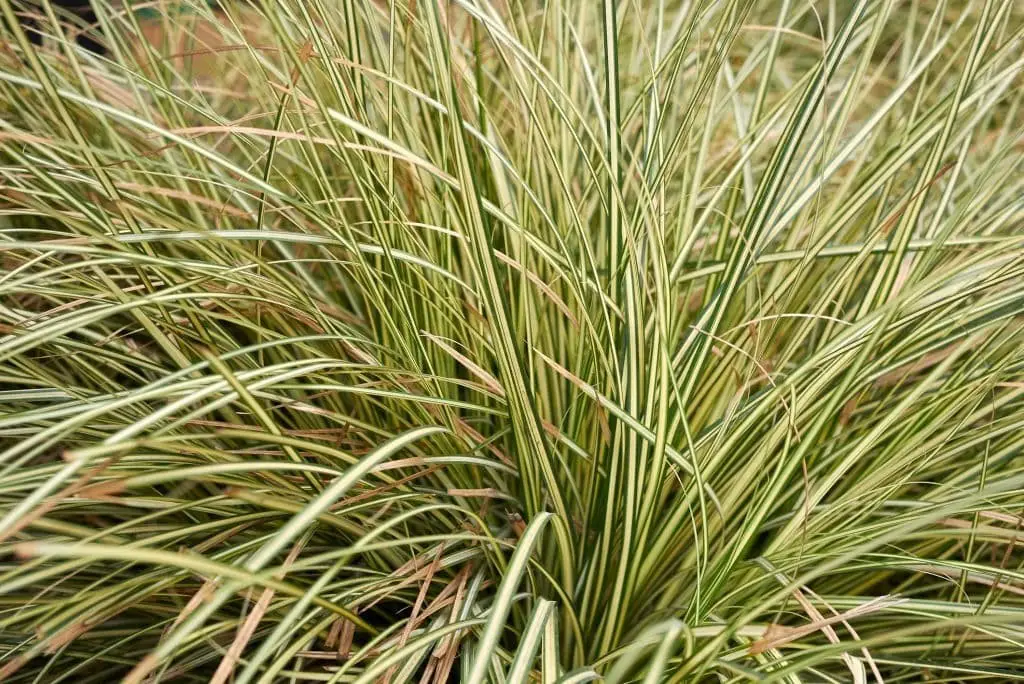
Carex spp., commonly referred to as Sedge, encompasses over 100 species and cultivars. Characterized by its densely clumped leaves, which resemble fountains in shape, this plant is renowned for its evergreen foliage that maintains a creamy hue throughout the year. As a versatile ground cover, ornamental grass, or broadleaf evergreen, it adds visual interest to damp regions, garden beds, and woodland gardens. With a mature height of 0.
5-1 ft, Sedge thrives in conditions ranging from full sun to partial shade, tolerating a wide range of soil types, including clay, silt, sand, rocky, and well-draining substrates. The plant’s adaptability is further demonstrated by its ability to grow in environments with an acidic, alkaline, or neutral pH. While Sedge produces brown or copper-colored flowers year-round, it is hardy in zones 7b-9a and native to the South New Zealand Isles.
#36. Japanese blood grass
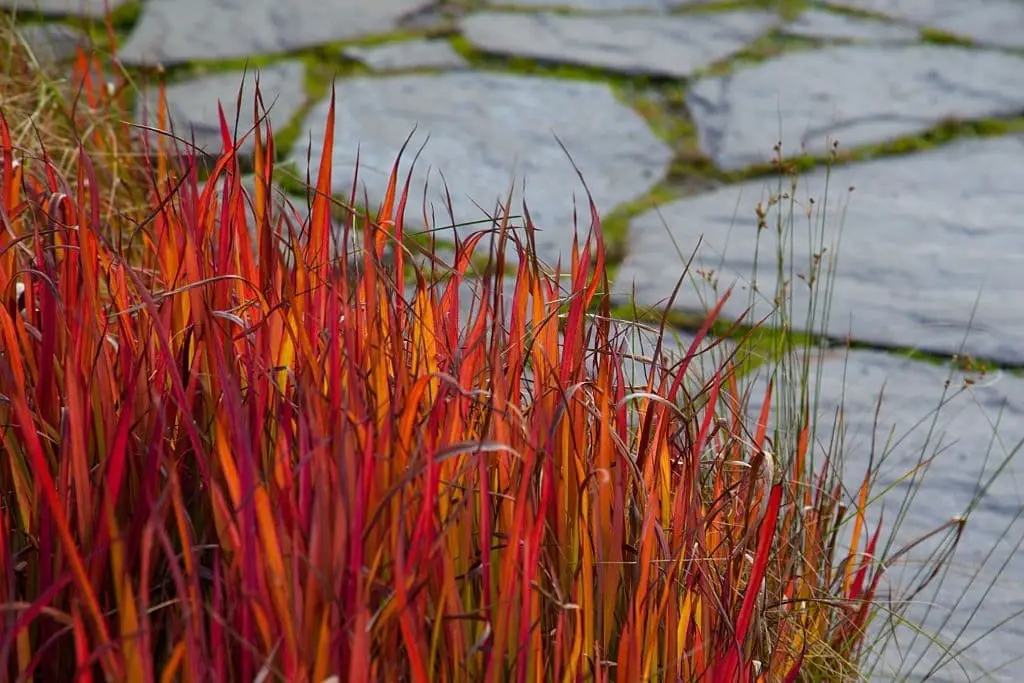
The Red Baron ornamental grass is a stunning specimen that boasts a unique characteristic – its leaves change colors with the seasons. During spring, they emerge bright green, only to transform into a vibrant cranberry red in summer and eventually turn burgundy in fall. As winter approaches, the plant enters dormancy, making it an excellent choice for adding contrast and accentuating other garden features. Its deer-resistant nature and low maintenance requirements only add to its appeal.
This hardy grass, scientifically known as Imperata cylindrica, goes by several common names including Red Baron. As a type of ornamental grass and ground cover, it can grow up to 2-4 feet in maturity. It thrives in full sun to partial shade, tolerating clay, loam, or well-drained soil with an acidic, alkaline, or neutral pH. Its year-round bloom period produces gray, silver, or white flowers, making it suitable for hardiness zones 5a-9a.
Interestingly, the Red Baron is native to Southeast Asia, Micronesia, Australia, Southern Europe, and Africa.
#37. Citronella grass
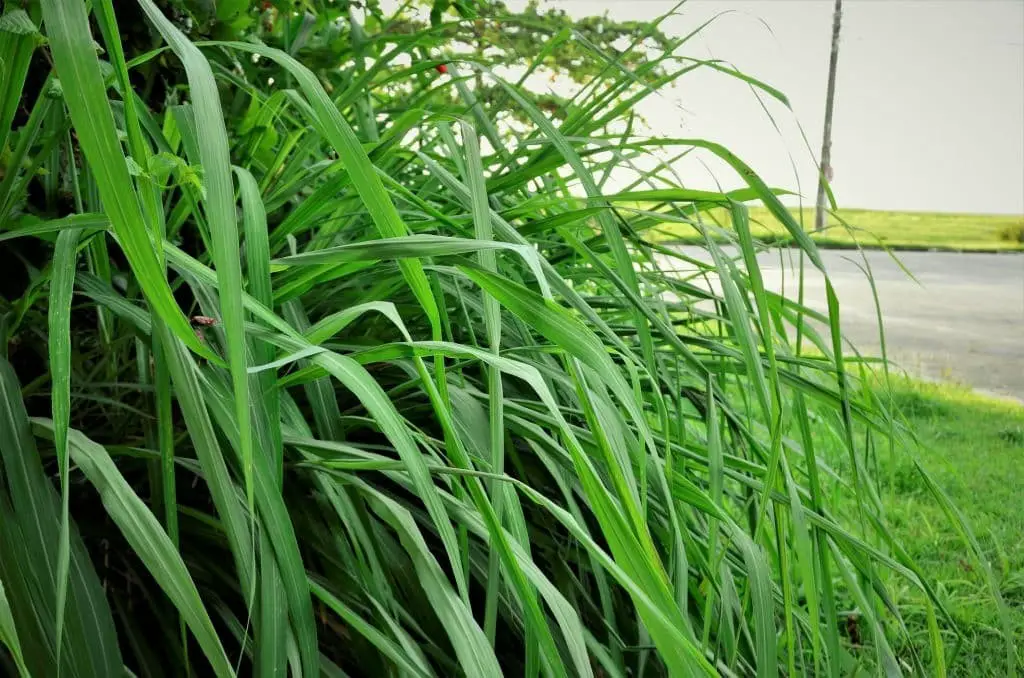
Citronella, a perennial grass with ornamental and medicinal properties, is renowned for its versatility. As one of the 12 most potent grasses for repelling insects and pests, such as mosquitoes, it has garnered significant attention. Additionally, the plant is processed to produce essential oils and fragrances.
Botanical Name: Cymbopogon nardus/winterianus
Common name: Citronella
Plant type: Ornamental, medicinal
Mature size: 4-6 ft
Sun exposure: Full sun to partial shade
Soil type: Loam, sandy, moist and well-draining
Soil pH: Neutral to slightly alkaline
Bloom time: Summer to fall
Flower color: Light brown
Hardiness zones: 10-12
Native Area: Southeast Asia
#38. Blue oat grass
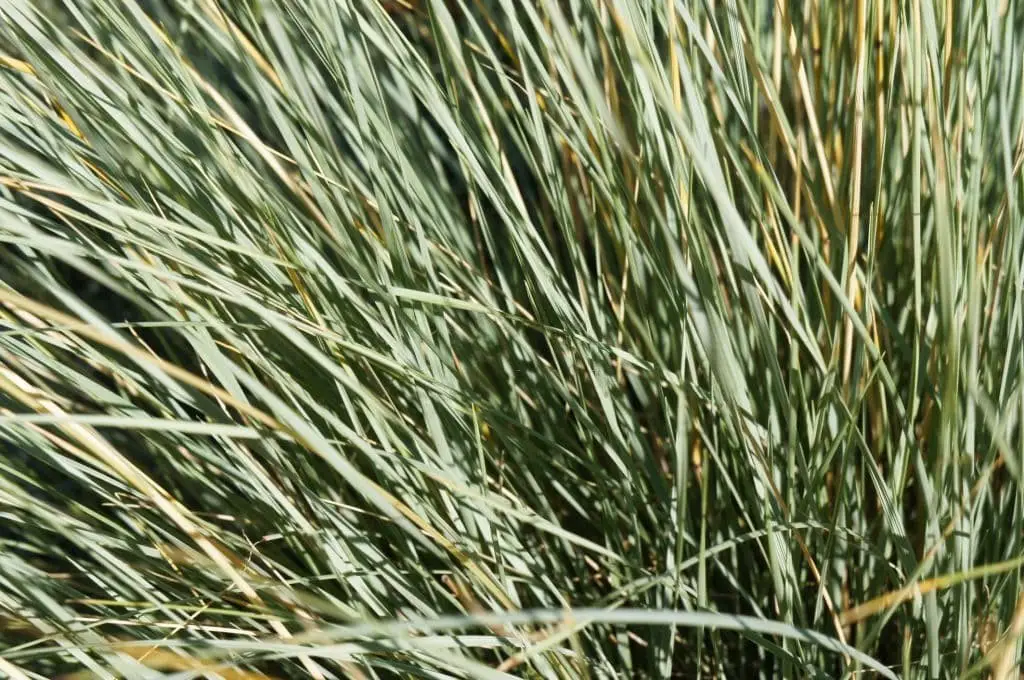
Blue oat grass (Helictotrichon sempervirens) is a perennial ornamental that boasts a striking blue-green hue year-round. Its dense, clump-forming growth habit sets it apart from its taller, more slender cousins in the tall fescue family. While some might mistake it for these lookalikes, blue oat grass stands out due to its larger size and more robust stature. As summer and fall arrive, this attractive grass produces showy blue flower panicles that add a pop of color to the landscape.
But even when the flowers have faded, the foliage remains a beautiful shade of blue-green, providing year-round interest. With its adaptability to a range of soil types – from sandy to heavy clay – and pH levels, from alkaline to neutral, blue oat grass is an excellent choice for gardeners seeking low-maintenance, attractive options. Its hardiness zones 4-9 also make it suitable for gardeners in cooler climates.
Native to the West Mediterranean region, this ornamental grass has a natural charm that’s sure to captivate.
#39. Miscanthus grass
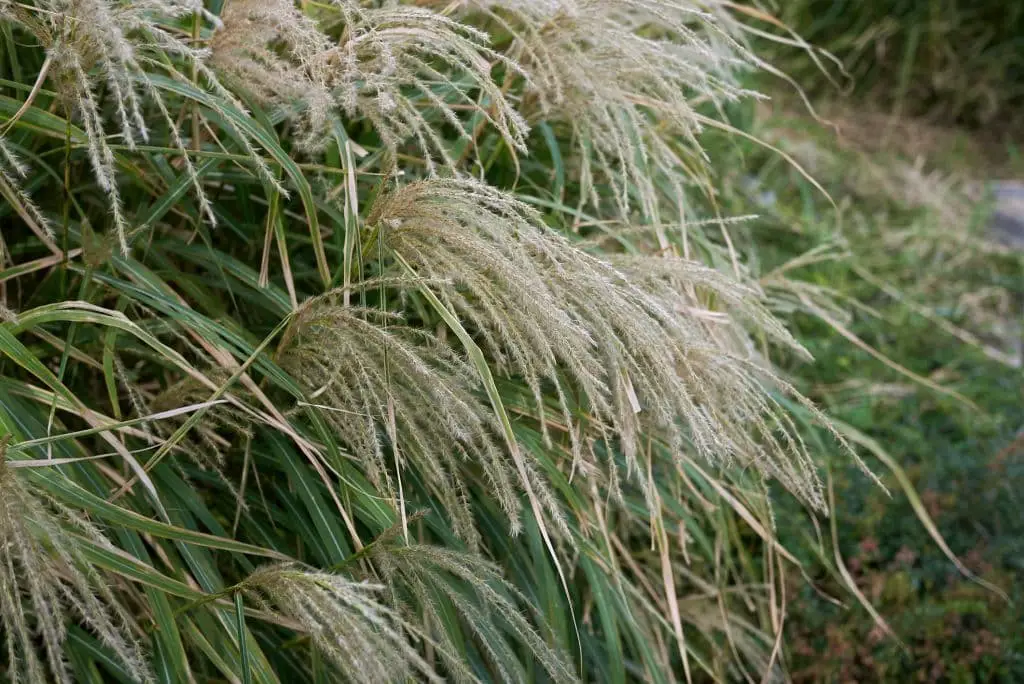
Miscanthus is a diverse group encompassing over 150 species and cultivars, including the popular zebra grass and maiden grass. This ornamental, clumping perennial boasts a unique foliage progression from green and coarse in spring to purple in fall and eventually brown or tan in winter. Its adaptability allows it to thrive in a range of conditions, tolerating both wet and dry soils as well as hot and temperate climates.
With its mature size reaching 8-12 feet, Miscanthus requires full sun to showcase its beauty. It prefers clay, silt, sand, or moist and well-draining soil types with an acidic to neutral pH range. The plant’s fall and winter blooms display a palette of cream, red, and burgundy hues. Hardy in zones 5a-9a, Miscanthus is native to Southeast Asia, Japan, and the Pacific region.
#40. Sudan grass
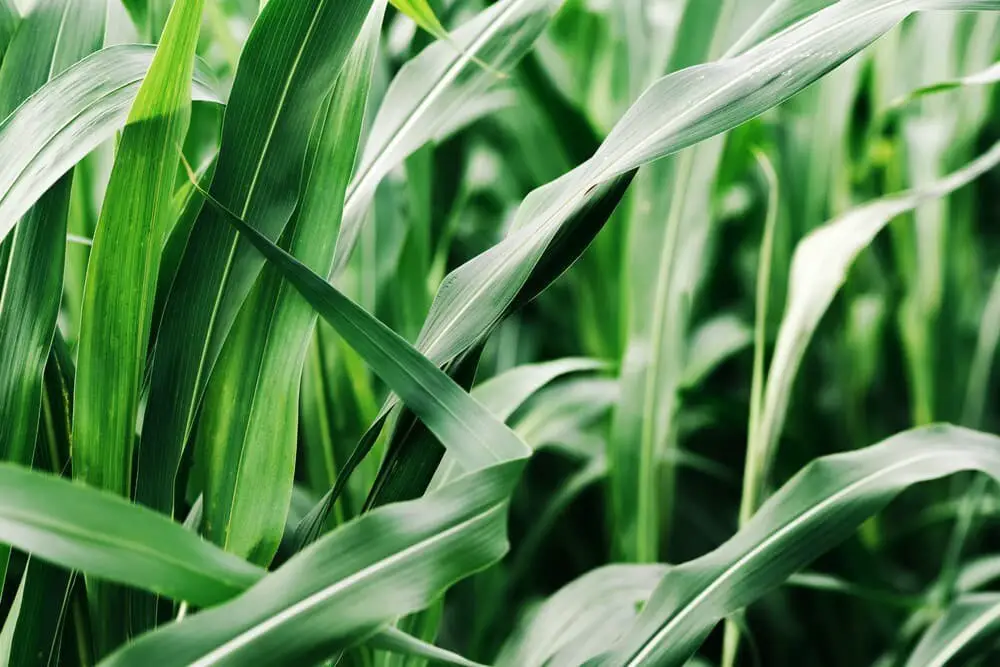
Hybrid sudan, also known as Sudan grass, is a fast-growing and warm-season grass that’s prized for its versatility. It’s often cultivated to prevent soil erosion, rebuild soil structure, and loosen compacted soils. This remarkable grass is a hybrid of sorghum and sudangrass, making it an excellent legume cover and forage crop. As a ground cover, Sudan grass is effective at suppressing weeds and nematodes, allowing other plants to thrive.
Its impressive features include its botanical name, Sorghum x drummondii, as well as its common names: Hybrid sudan and Sudan grass. When mature, the plant reaches heights of 3-4 feet. Sudan grass thrives in conditions that are full sun to partial shade, with a preference for sandy or loamy soils that drain moderately to well. It can tolerate slightly acidic to neutral soil pH levels, making it a hardy choice for many gardeners.
Interestingly, this West African native is hardy in zones 5-9, making it an attractive option for those living in temperate climates.
#41. Barnyard grass
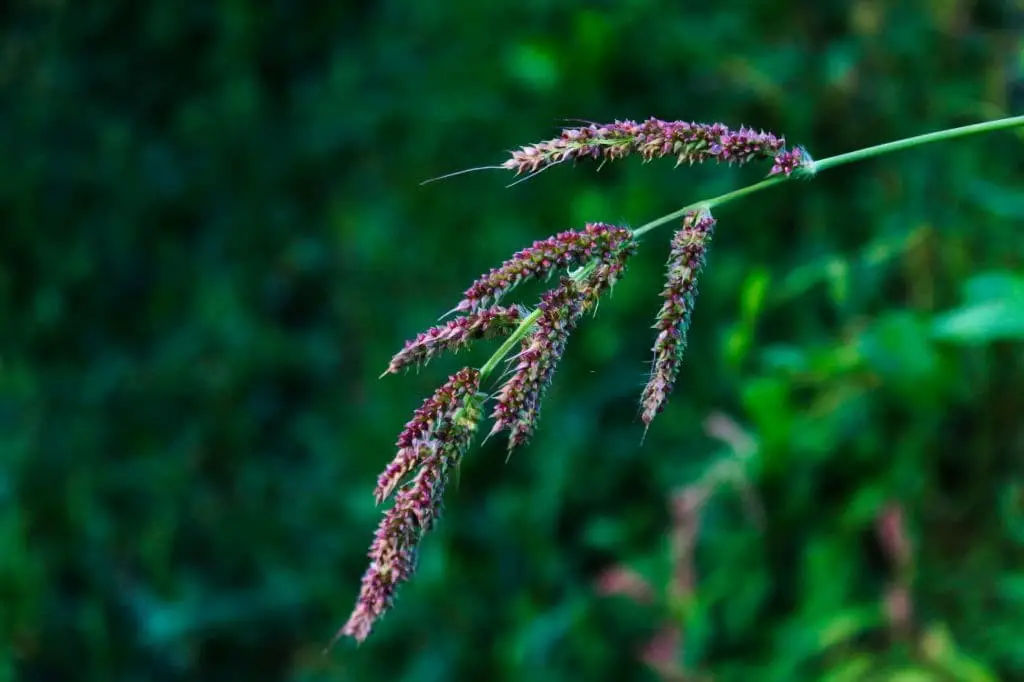
Cockspur grass, also known as Echinochloa crus-galli, is a ubiquitous agricultural weed characterized by its flat, blade-like leaves that become increasingly flattened as they grow from the stem base. Its ability to produce its own seeds has contributed to its invasive nature. On a more positive note, this annual grass produces tiny purple flowers, making it a suitable accent grass for landscaping purposes.
Botanically speaking, Cockspur grass is a native annual that can reach maturity heights of 3.5-6 feet in ideal conditions. It thrives in full sun to partial shade and can tolerate a range of soil types, including clay, loam, and well-draining soils with acidic or neutral pH levels.
In terms of its flowering habits, Cockspur grass produces purple blooms during the summer and fall months. Its hardiness zones are 5-9, indicating that it is well-suited for growth in a variety of climates.
Interestingly, this invasive species originates from Southeast Asia and Central/South America.
#42. Goosegrass
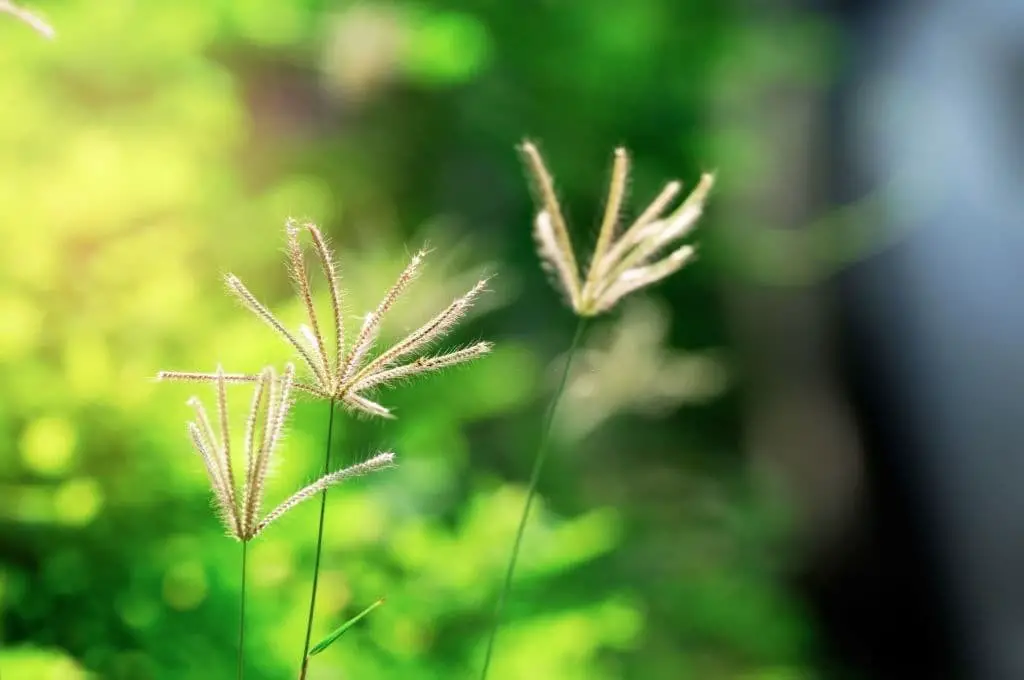
Eleusine indica, also known as Wire grass or bull grass, is a unique plant species that boasts pale-green stems, deep green, flat and folded leaves. Its foliage is not only aesthetically pleasing but also impressively tough – so much so that mature leaves cannot be cut by ordinary cutting tools. This resilient quality is mirrored in the plant’s strong roots, which enable it to grow rapidly and thrive in a range of compact soil conditions.
If left unchecked, Eleusine indica has the potential to become invasive due to its ability to produce its own seeds. With its impressive growth habit reaching up to 4 ft in height, this ornamental plant is well-suited to areas receiving partial to full sun exposure. It can flourish in a variety of soil types, including clay-loam, sandy, shallow rocky, and moist to slightly dry conditions. The ideal soil pH range for Eleusine indica lies between acidic and neutral levels.
In the fall season, this plant produces greenish-white flowers, adding an extra layer of visual interest to its already impressive profile. Its hardiness zones extend from 8-11, making it suitable for growth in a range of environments. Native to Australia, New Zealand, and Scandinavia, Eleusine indica is a fascinating plant species that offers something unique to gardeners and naturalists alike.
#43. Torpedo grass
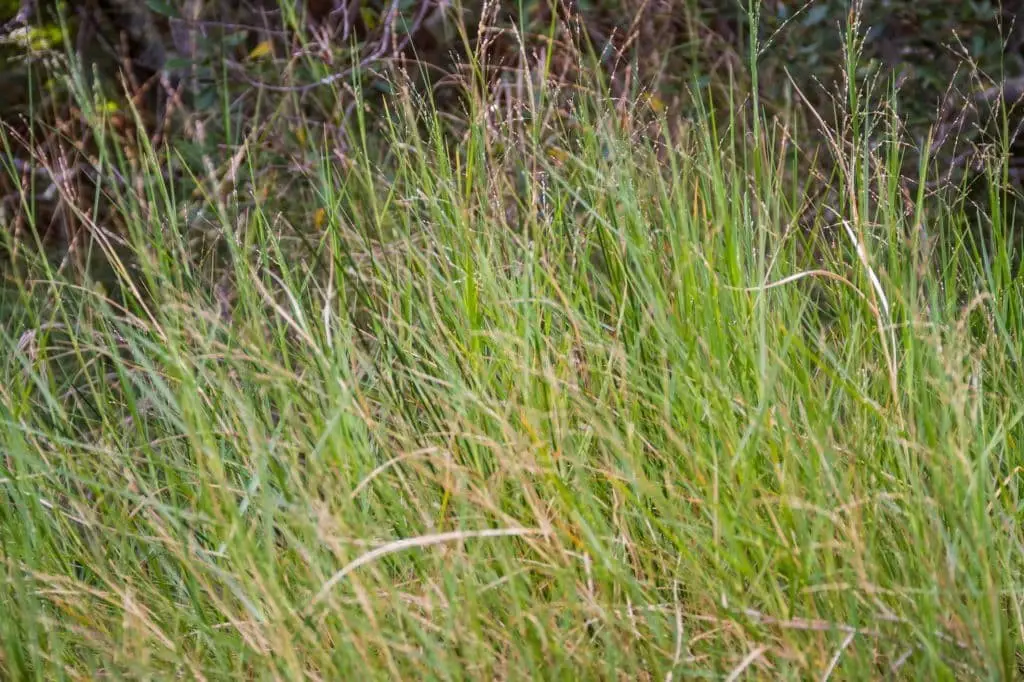
Panicum repens, also known as Bullet grass or panic rampant, is a unique aquatic herbaceous perennial with some distinct characteristics. Its leaves are grayish green in color, narrowly shaped, and rolled inwardly. The plant’s rootstock and rhizome roots feature white-brown scales, while its ability to produce its own seeds allows it to spread quickly – sometimes becoming invasive and targeting rice fields.
The botanical name for this species is Panicum repens, and it’s often found growing in full sun to partial shade. It thrives in sandy, moist soil that drains well, tolerating a mildly acidic to neutral pH. As an aquatic grass/sedge, it reaches maturity at around 3ft tall. While its flowers may be insignificant, the plant produces blooms during both summer and fall seasons. Its hardiness zones range from 8a to 11a, with native areas in Africa and Asia.
What is the world’s tallest grass?
Elephant grass, also known as Napier grass, stands tall among the world’s most impressive blades of grass. Reaching heights of up to 12 feet, this tropical gem boasts long, flat leaves that provide an abundance of benefits. Its popularity stems from its uses in livestock feed and erosion control, making it a valuable asset for farmers and land managers alike.
One of the greatest advantages of elephant grass is its ability to be harvested multiple times a year, providing a reliable source of sustenance. Rich in protein and minerals, this natural wonder offers an excellent alternative to synthetic supplements, allowing individuals to nourish their bodies with wholesome ingredients.
Beyond its nutritional value, elephant grass also boasts impressive resistance to common pests and diseases, rendering it a trustworthy choice for sustainable land management practices. In some regions, it’s even harnessed as a renewable source of fuel due to its high energy content, further solidifying its reputation as a versatile and valuable crop.
Where is the longest grass in the world?
The Serengeti National Park in Africa boasts an extraordinary feat – the longest grass in the world. Spanning over 4,500 plant species, including tall varieties like red oat grass, yellow top grass and umbrella thorn acacia, this lush vegetation is a haven for the park’s abundant wildlife. The majestic grasslands can reach up to 12 feet high, providing an ideal habitat for zebras, gazelles, elephants and other large mammals to roam freely. It’s truly a breathtaking sight!
But that’s not all – the Serengeti also comprises diverse ecosystems, featuring woodlands, rocky hills, vast lakes and wetlands. This incredible biodiversity makes it a prime destination for wildlife enthusiasts, with many visitors flocking to witness the park’s remarkable array of species. With its awe-inspiring landscapes, abundant wildlife and record-breaking grasses, the Serengeti is undoubtedly a must-visit for nature lovers.
Conclusion
Grass may seem like a straightforward landscape component, but it’s actually comprised of diverse types with distinct purposes. One surprising aspect is that many grasses produce flowers – a far cry from the common perception of just grass and plumes. This multifaceted nature makes them suitable not only for ground covering and turf grass but also as ornamental features. Nevertheless, some grasses can become invasive if not managed properly.
Therefore, it’s crucial to understand how to plant, maintain, and care for each type individually, which involves researching their unique profiles.
Related Posts
When it comes to lawn care, tipping lawn service workers is not a common practice. However, just like in any industry, it’s essential to understand the etiquette surrounding gratuities. As we delve into the world of sustainable field makeovers and lawn maintenance, it’s crucial to explore the importance of oversowing your lawn. For beginners looking to grow grass seeds, this process can be intimidating, but with the right guidance, it can be a successful endeavor.
Additionally, creeping thyme lawns offer unique benefits and drawbacks, making it essential to understand how to plant and maintain them.



